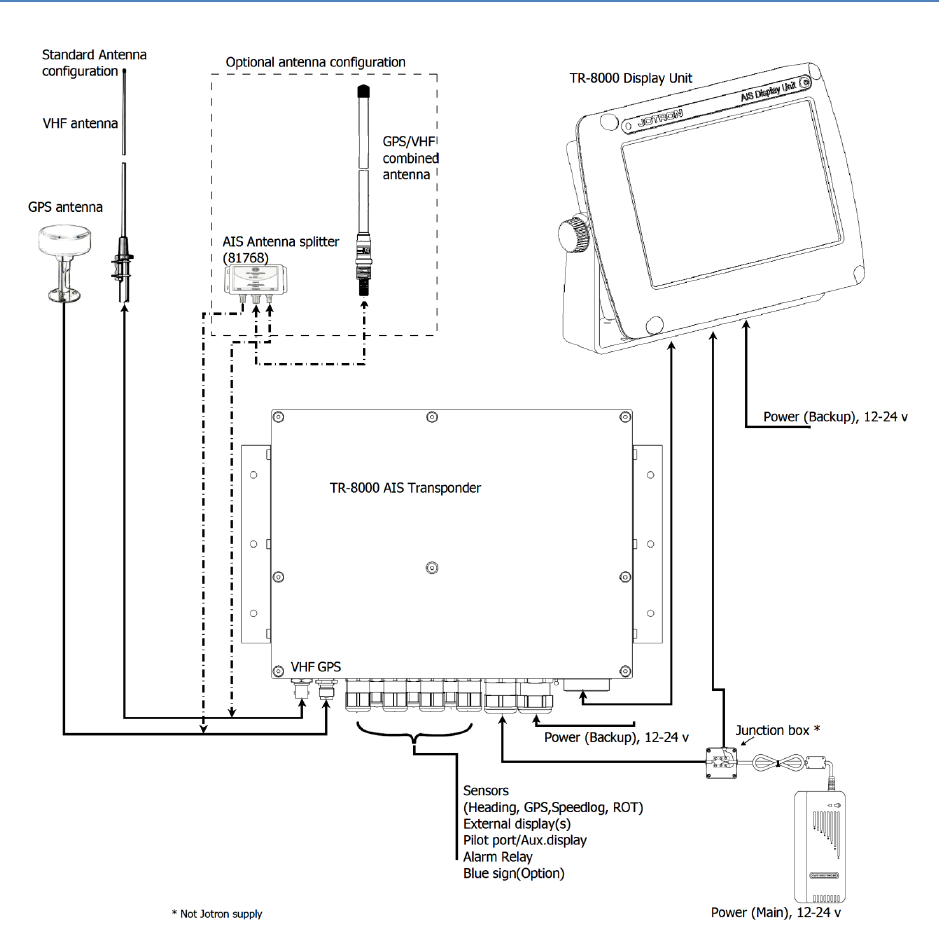Jotron AS TR8000 Tron AIS TR-8000 User Manual Operator and Installation Manual part 2
Jotron AS Tron AIS TR-8000 Operator and Installation Manual part 2
Contents
- 1. Technical Manual
- 2. Operator and Installation Manual part 1
- 3. Operator and Installation Manual part1
- 4. Operator and Installation Manual part 2
- 5. Operator and Installation Manual part 3
Operator and Installation Manual part 2
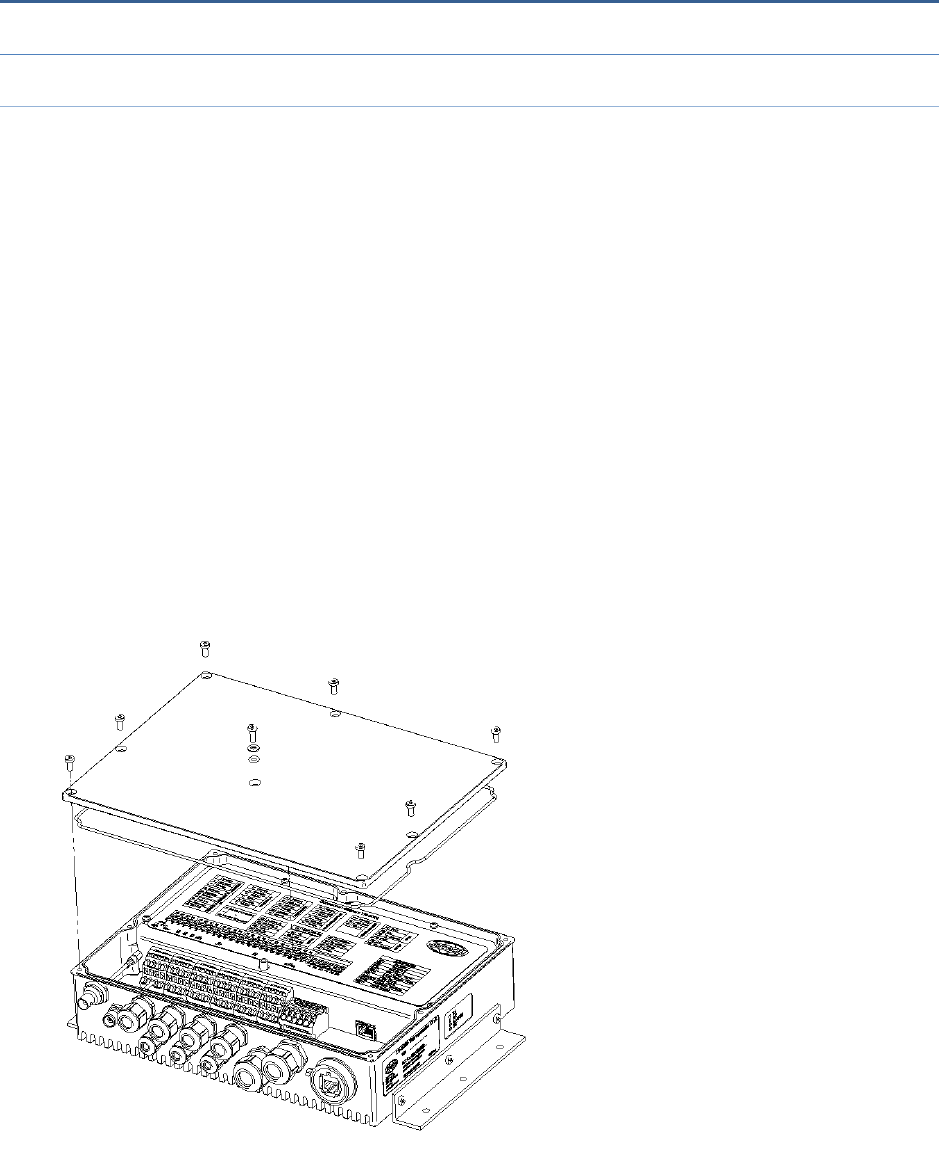
TR-8000 Operator and Installation Manual 39
8 Installation
8.1 Mechanical Mounting
8.1.1 Transponder unit
Use the standard Mounting Kit. For dimensions and positioning of holes see Figure 14-1 TR-8000
Transponder Unit- mechanical dimensions
When selecting a mounting location for the Transponder the following guidelines apply:
1. Keep the transponder out of direct sunlight.
2. Do not mount the transponder were it can be directly exposed to seawater as corrosion
then may appear and cause leakage.
3. The unit must not be mounted near exhaust pipes and vents.
4. Even though the transponder is a robust unit, it is advised that it should be mounted were
shock and vibration are minimal.
5. Unit shall not be located near electromagnetic field generating equipment
6. Leave sufficient space at the sides and top of the unit for maintenance and repair.
Also leave slack in cables for the same reason.
7. Do not mount transponder unit too close to a magnetic compass :
Compass safe distance: Standard Compass: 95cm
Steering Compass: 65cm
The TR-8000 transponder unit can be
mounted in all directions, either on a wall,
roof or floor. The unit is very robust and
made of cast aluminum coated with black
paint for best type of protection
For detailed mechanical drawings, see
chapter 14,”Outline Drawings”
Figure 8-1 Transponder Unit, exploded view. Opening of outer Lid

TR-8000 Operator and Installation Manual 40
8.1.2 Display Unit
The display unit can be installed as desktop mounted, roof mounted or flush mounted in a panel.
Installation shall be near the conning position.
When selecting a mounting location for the Display Unit the following guidelines apply:
1. Do not mount the display unit were it can be directly exposed to seawater as corrosion
then may appear and cause leakage.
2. The unit must not be mounted near exhaust pipes and vents.
3. Even though the transponder is a robust unit, it is advised that it should be mounted were
shock and vibration are minimal.
4. Unit shall not be located near electromagnetic field generating equipment
5. Leave sufficient space at the back for connection to necessary cables.
6. Do not mount transponder unit too close to a magnetic compass :
Compass safe distance: Standard Compass: 30cm
Steering Compass: 14cm
8.1.2.1 Desktop Mounting
For detailed mechanical drawings, see chapter 14,”Outline Drawings
Figure 8-2 Desktop mounted Display Unit
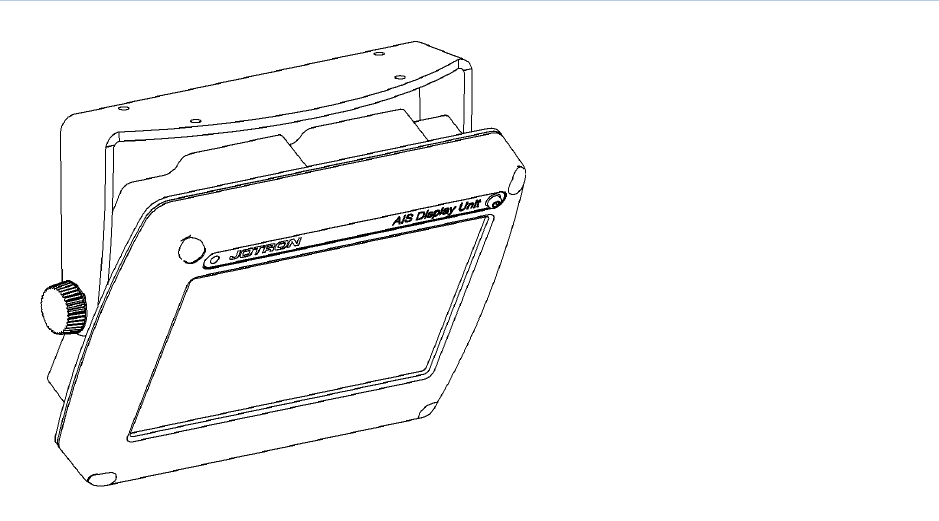
TR-8000 Operator and Installation Manual 41
8.1.2.2 Roof Mounting
When display unit is mounted
overhead/roof, it might be necessary to
adjust Contrast/Brightness, see chapter 7.5
Display Settings
For detailed mechanical drawings, see chapter 14 Outline Drawings
Figure 8-3 Roof mounted Display Unit
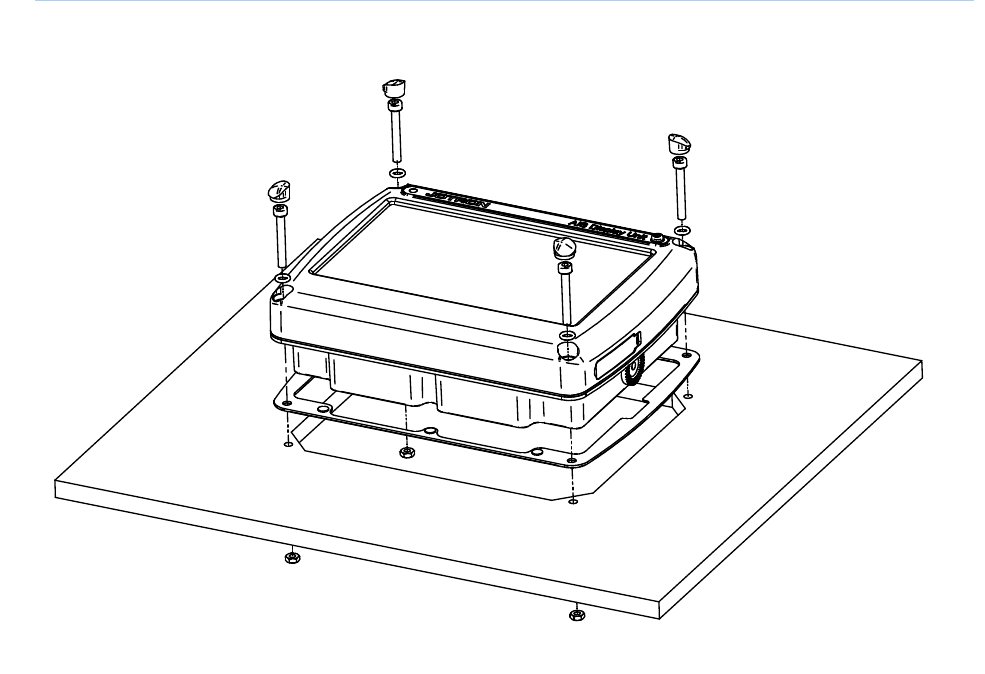
TR-8000 Operator and Installation Manual 42
8.1.2.3 Flush/ Panel Mounting
For detailed mechanical drawings, see chapter 14 Outline Drawings
Figure 8-4 Flush mounted Display Unit, exploded view.
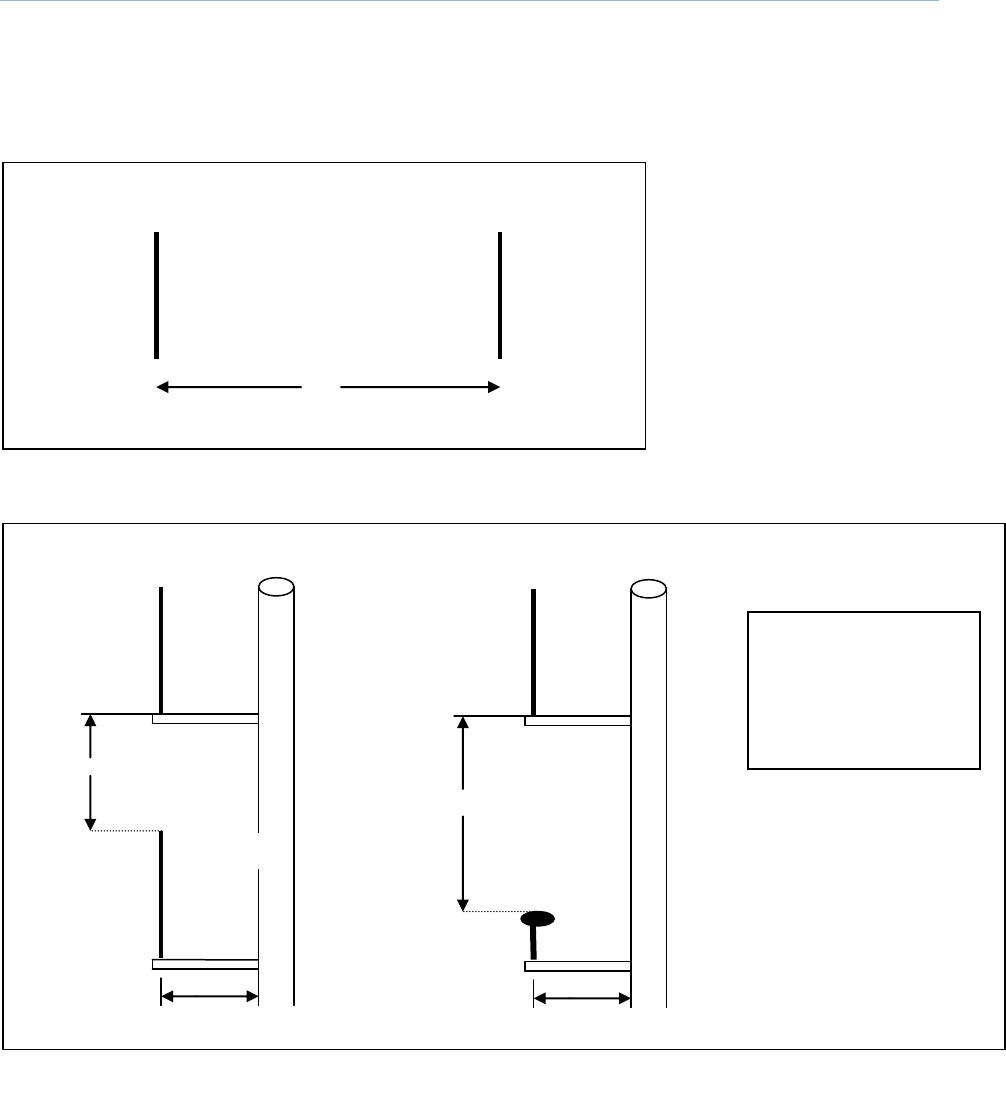
TR-8000 Operator and Installation Manual 43
8.1.3 Antennas
As a general rule, longer horizontal distances to other antennas will minimize the interference and
improve reception on all antennas.
Minimum distance is described in the figures below:
VHF antenna for AIS:
Other VHF antenna
or GPS antenna
>10 meters
>0,5 meter
>0,5 meters
VHF antenna for AIS:
See subchapters
below for detailed
description
VHF antenna for AIS:
> 2.5 meters
GPS
antenna
> 2.5 meters
Other VHF
antenna
Figure 8-5 Horizontal separation distance.
Figure 8-6 Vertical separation and distance from mast or other object of metal. For best isolation between antennas, place
directly underneath with no horizontal separation.
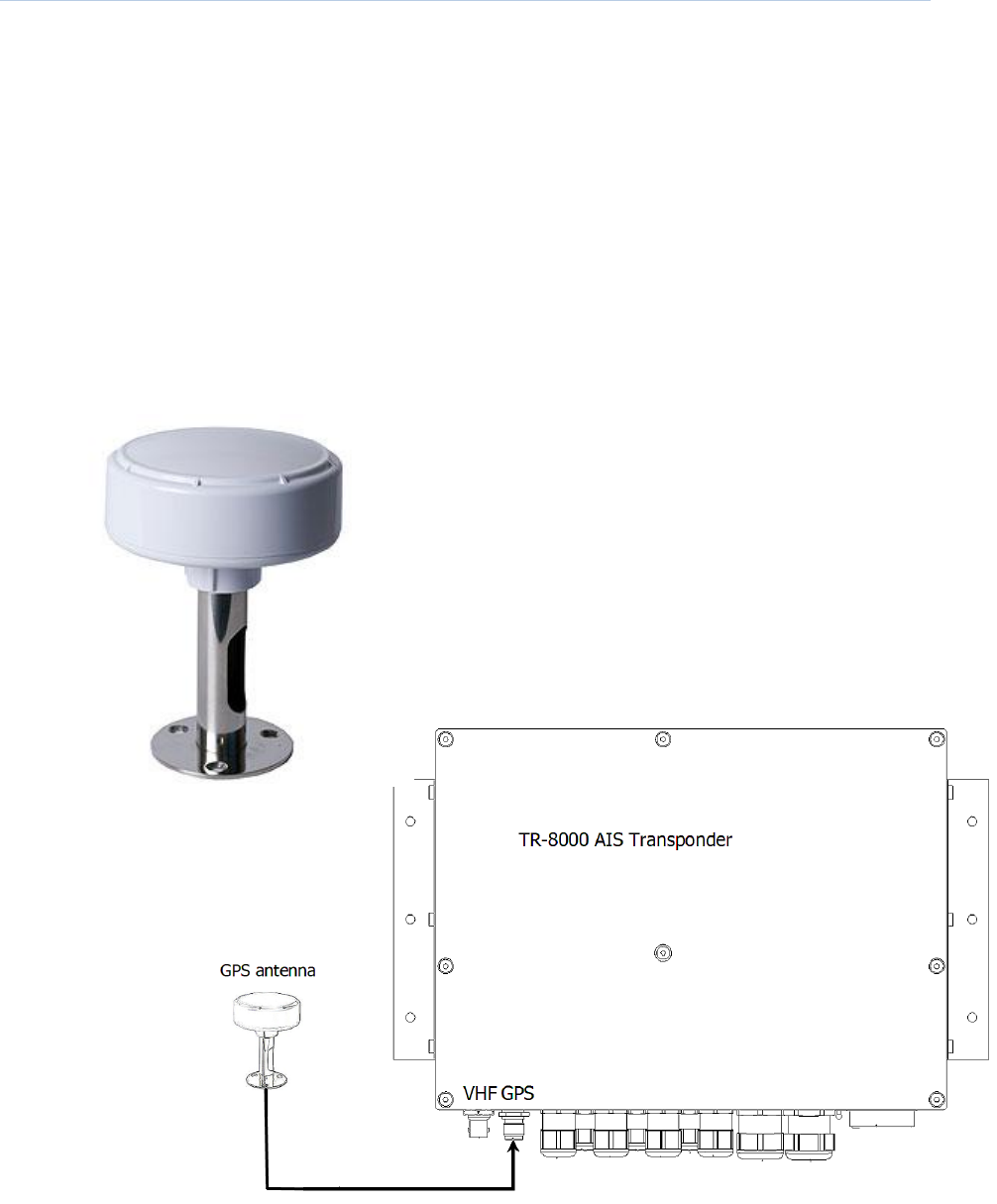
TR-8000 Operator and Installation Manual 44
8.1.3.1 GPS Antenna
When selecting a mounting location for the antenna, keep in mind the following points.
1. Select a location out of the radar beam. The radar beam will obstruct or prevent reception
of the GPS satellite signal.
2. There should be no interfering object within the line-of-sight to the satellites. Objects within
the line-of-sight to a satellite, for example a mast, may block reception or prolong acquisition
time.
3. Mount the antenna unit as high as possible to keep it free of interfering objects and water
spray, which can interrupt reception of GPS satellite signal if the water freezes.
8.1.3.1.1 Standalone type
TR-8000 is delivered as standard with a Sanav SA-
200 GPS antenna with stainless steel stand and 15
meter cable with TNC connectors in both ends for
direct connection between transponder and antenna.
The antenna can be mounted with three 6 mm
bolts.
When Standalone GPS antenna is used, an additional
VHF antenna must also be connected
For detailed description of this antenna, see Chapter 14
Outline Drawings
Calculation of cable length/attenuation etc is described in chapter 8.2
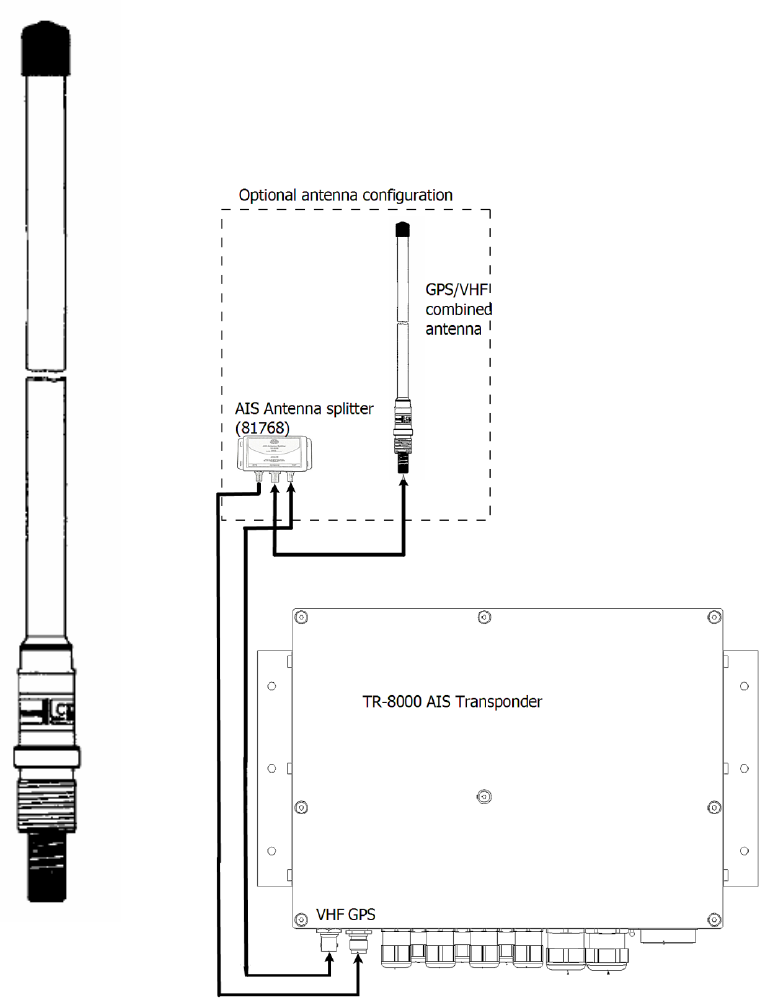
TR-8000 Operator and Installation Manual 45
8.1.3.1.2 Combined VHF/AIS
As an option to the individual VHF and GPS antennas, a combined antenna may be
used in conjunction with a signal splitter which will provide a common cable between
the signal splitter and the antenna, and two short jumper cables between splitter and
transponder.
The combined antenna is delivered with a mounting bracket to be mounted on a
mast .
Calculation of cable length/attenuation etc is described in chapter 8.2
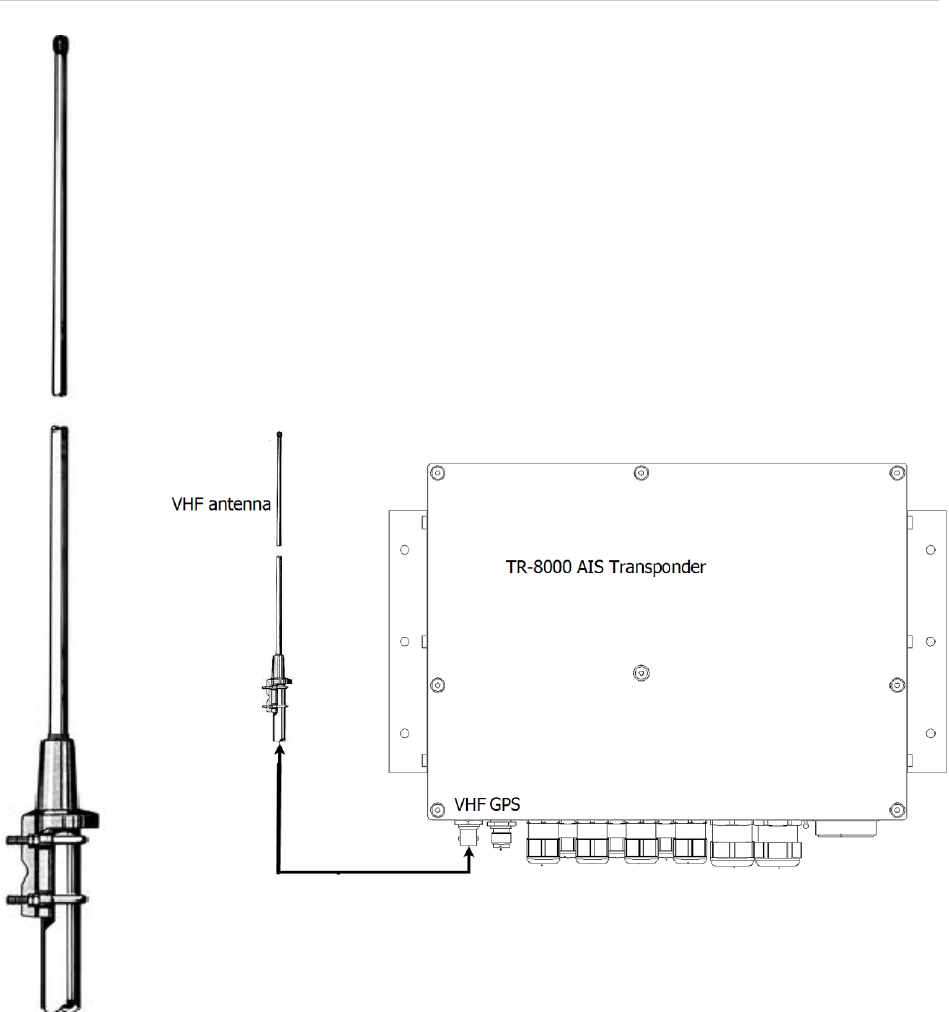
TR-8000 Operator and Installation Manual 46
8.1.3.2 VHF Antenna
When individual GPS antenna is used, the additional VHF antenna must also be
connected
For detailed description of this antenna, see Chapter 14 Outline Drawings
Location of the mandatory AIS VHF-antenna should be carefully considered. Digital
communication is more sensitive than analogue/voice communication to interference
created by reflections in obstructions like masts and booms. It may be necessary to
relocate the VHF radiotelephone antenna to minimize interference effects.
Install the VHF antenna referring to drawings in beginning of this chapter
The antenna should be connected using RG214 cable or better using the connectors
in the “Plug Kit” which is delivered with the units.
Calculation of cable length/attenuation etc is described in chapter 8.2
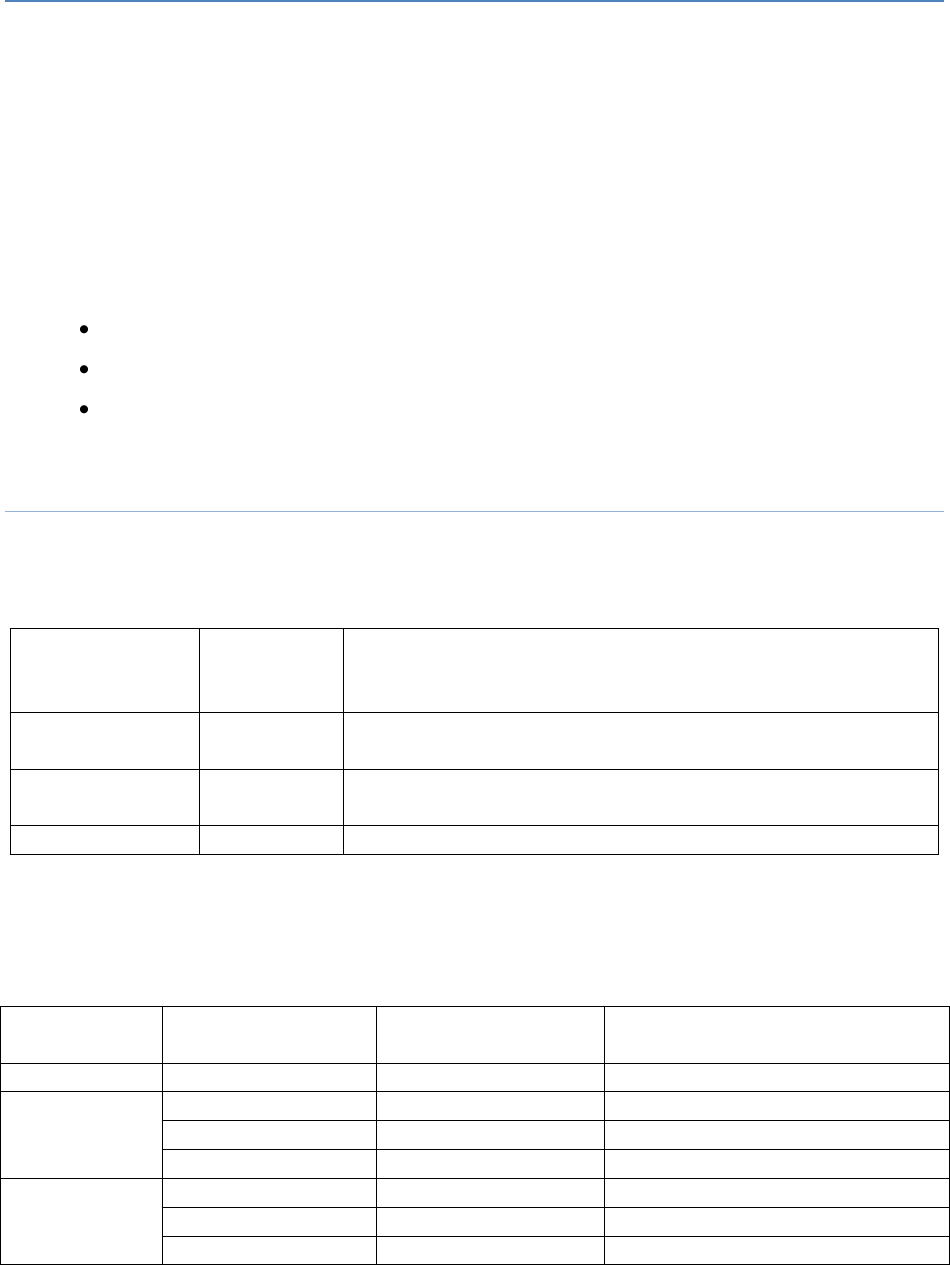
TR-8000 Operator and Installation Manual 47
8.2 Cabling
All outdoor installed connectors on coaxial cables should be fitted with preventive isolation such as
vulcanizing tape to protect against water penetration into the antenna cable.
Coaxial cables should be installed in separate signal cable channels/tubes and at least 10 cm away
from power supply cables. Crossing of cables should be done at right angles (90°). The minimum bend
radius of the coaxial cable should be 5 times the cable's outer diameter.
The cables should be kept as short as possible to minimize signal attenuation.
The type of cables used onboard vessels should be:
Halogen free
Fire resistant or Flame retardant type
Low smoke
8.2.1 GPS antenna
The table below gives recommendations on cables that can be used for the GPS antenna
connections:
Type
Attenuation
@1.5 GHz
(dB/100m)
Remark
RG58
90
Default for use if length< 20 m and
antenna = Procom GPS4 or SANAV SA-200
RG214
35
If combined GPS/VHF antenna from either AC-Marine, Procom
or Comrod is used, this or better can be used
RG225
30
Cable with lower loss
For optimum performance of the transponder approximately +10dB gain should be available when the
cable attenuation has been subtracted from the GPS antenna preamplifier gain. Note that Procom
AIS2/GPS and Comrod AC17-AIS are combined VHF/GPS antennas and additional attenuation from
connectors/ diplexer must be taken in consideration. Some examples below:
Cable Type
Antenna
Preamplifier Gain
(dB/100m)
Recommended cable length (m)
RG58
Procom GPS4
30
<20 meter
RG214
Procom AIS2/GPS
28
10-30 meter
Comrod AC17-AIS
20
10-20 meter
AC Marine VHF/GPS-B
18
10-20 meter
RG225
Procom AIS2/GPS
28
10-40 meter
Comrod AC17-AIS
20
10-30 meter
AC Marine VHF/GPS-B
18
10-30 meter

TR-8000 Operator and Installation Manual 48
8.2.2 VHF antenna
The table below shows the attenuation on the VHF frequencies with different cable types:
Cable Type
Attenuation @150
MHz (dB/100m)
Diameter (mm)
Weight (kg/100m)
RG214
7
10,8
18,5
RG225
8
10,9
23,3
Example: A RG 214 cable with length of 40 meters will have an attenuation of 2,8 dB.
Please keep the cables as short as possible, and be aware that 3 dB losses mean only half the output
power. If you have a transmitter delivering 12,5 W, and you have 3 dB losses in the cable, only 6,25
Watts will be at the antenna.
8.2.3 Cable between Transponder and Display Unit
The cable connecting the Transponder and the Display Unit has specially designed connectors on each
end for waterproofing. The cable itself is a standard CAT-5 network cable
In order to ease wiring and installation, an optional cable is available with one end open, delivered with
a small kit for post wiring assembly.
If the specified cable type is not used, the splash proofing of the unit is seriously degraded and the
warranty is void if used in humid environment.
Figure 8-7 Connection cable for interconnection between the Transponder and the Display Unit
NOTE! If the units are mounted indoors in a warm dry environment without any need for water
tightness, a standard CAT-5 or CAT-6 network cable may be used between the Transponder
and the Display unit
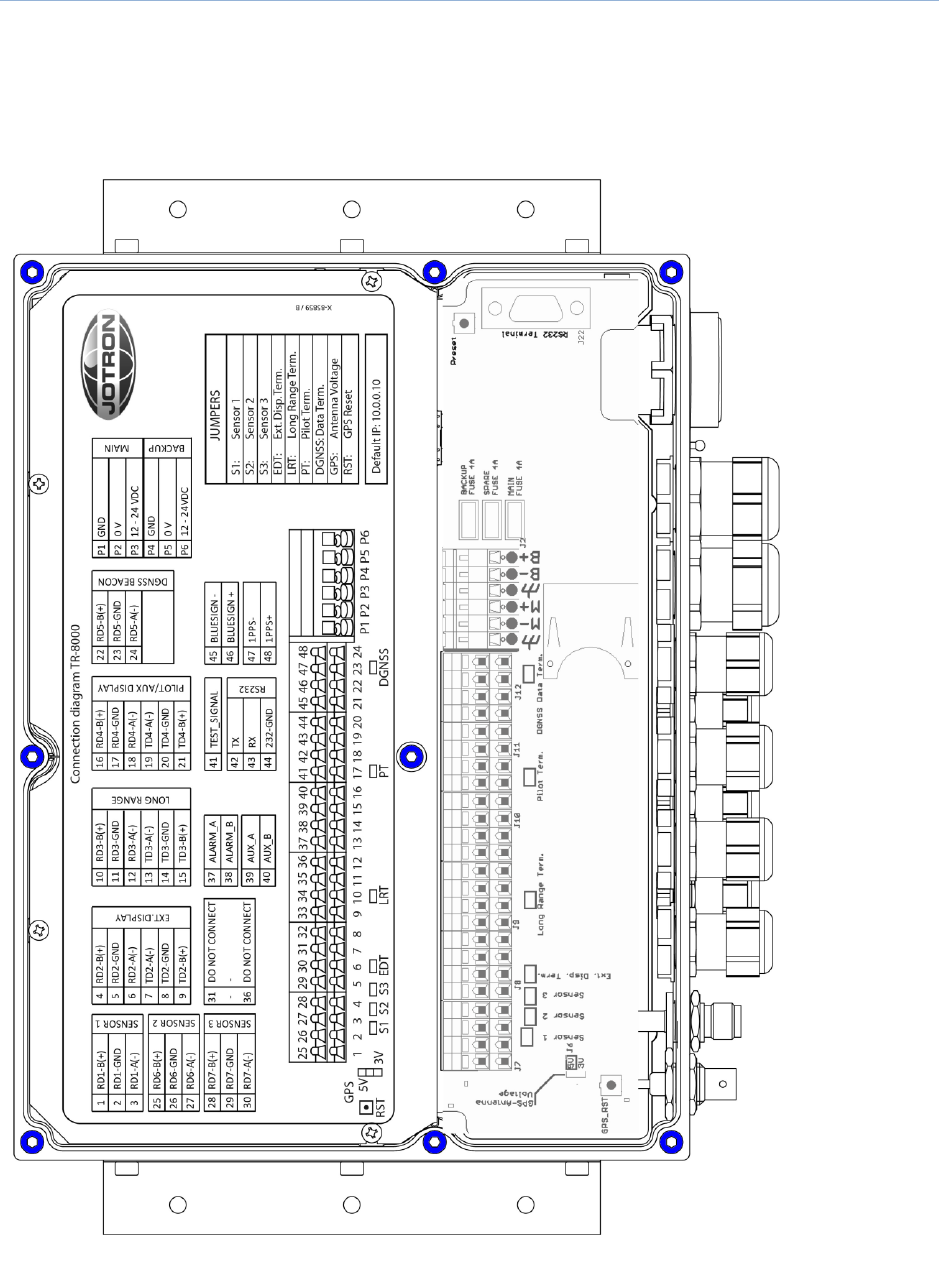
TR-8000 Operator and Installation Manual 50
8.3.1 Transponder
In order to connect all sensors and external connections to the Transponder Unit, the lid must be
removed by removing the screws on top of the unit. Pay attention to the seal gasket on the inside of the
lid and the small o-ring positioned on the center screw. These gaskets need to be in place when
mounted in order to keep the unit waterproof. When the lid is off, the connections to sensors, ECS etc
can be made. The inner lid shall not be removed by user.
Figure 8-9 Transponder with lid removed, lid screws highlighted

TR-8000 Operator and Installation Manual 51
8.3.1.1 Pictorial display of typical connections to the transponder
Figure 8-10: Typical connections to a TR-8000 transponder, dashed lines shows options
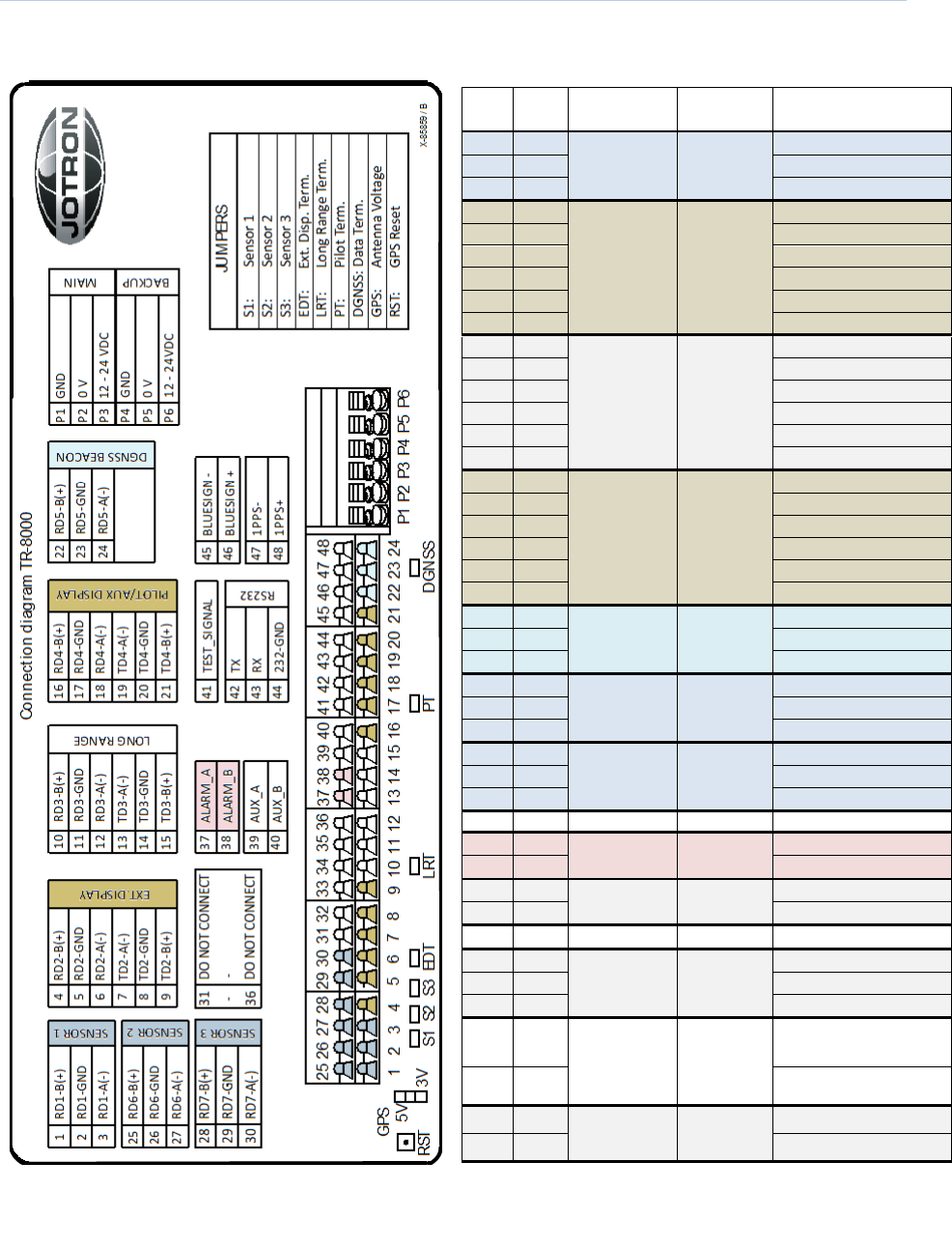
TR-8000 Operator and Installation Manual 52
8.3.1.2 Label in transponder with connection tables
Label: Connections table (Except power):
#
In/
Out
Type
Usage
Name
1
In
IEC61162-1
(RS422)
Sensor 1
RD1-B(+)
2
RD1 -GND (Iso Gnd)
3
In
RD1-A(-)
4
In
IEC61162-2
(RS422)
External
Display
RD2-B(+)
5
RD2-GND (Iso Gnd)
6
In
RD2-A(-)
7
Out
TD2-A(-)
8
TD2-GND (Iso Gnd)
9
Out
TD2-B(+)
10
In
IEC61162-2
(RS422)
Long Range
RD3-B(+)
11
RD3-GND (Iso Gnd)
12
In
RD3-A(-)
13
Out
TD3-A(-)
14
TD3-GND (Iso Gnd)
15
Out
TD3-B(+)
16
In
IEC61162-2
(RS422)
Pilot / Aux
Display
RD4-B(+)
17
RD4-GND (Iso Gnd)
18
In
RD4-A(-)
19
Out
TD4-A(-)
20
TD4-GND (Iso Gnd)
21
Out
TD4-B(+)
22
In
IEC61162-1
(RS422)
DGNSS
Beacon
RD5-B(+)
23
RD5-GND (Iso Gnd)
24
In
RD5-A(-)
25
In
IEC61162-1
(RS422)
Sensor 2
RD6-B(+)
26
RD6-GND (Iso Gnd)
27
In
RD6-A(-)
28
In
IEC61162-1
(RS422)
Sensor 3
RD7-B(+)
29
RD7-GND (Iso Gnd)
30
In
RD7-A(-)
31-36
NC
37
Out
Relay (NO)
Alarm
ALARM_A
38
Out
ALARM_B
39
Out
Relay (NO)
Auxiliary
Relay
AUX_A (Don’t connect)
40
Out
AUX_B ( ---“--- )
41
NC
Test signal
Test signal
(not isolated)
42
Out
RS232C
RS232
TX ( Transmit)
43
In
RX ( Receive)
44
232-GND( Ground )
45
In
Optoisolated
(Connect +
and – for
activation)
Bluesign
BLUESIGN - (Inland
functionality)
46
In
BLUESIGN + ( ---“--- )
47
In
( ---“--- )
1PPS
1PPS - (Don’t connect)
48
In
1PPS + ( ---“--- )
Figure 8-11: Label inside transponder with corresponding table showing details about each connection. It is coloured to
differentiate sensors, display/pilot, alarm and DGNSS beacon interface
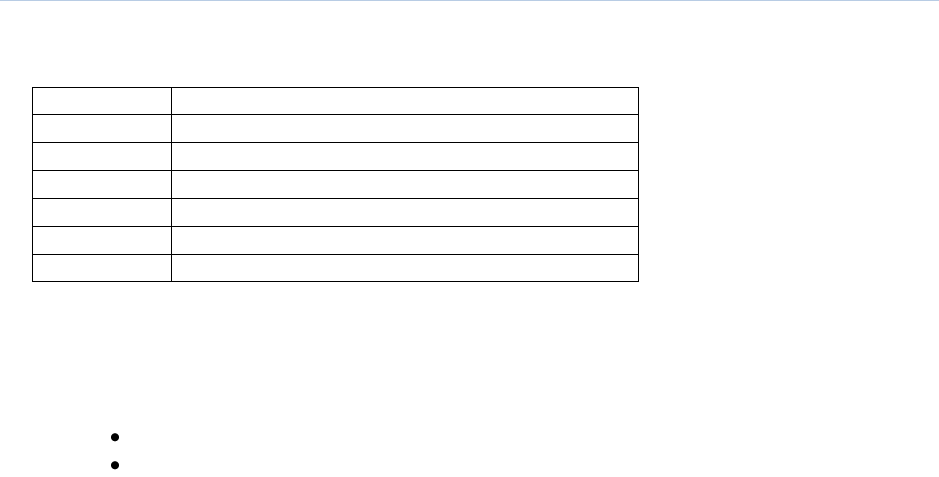
TR-8000 Operator and Installation Manual 53
8.3.1.3 Power connection
Table showing connection of main and backup power
See also figure Figure 8-10
Allowed voltage levels of the power supply to be connected with the transponder:
Minimum = 10.8 volt
Maximum = 31.2 volt
Recommended cable diameter: 2.5 – 4 mm2
Connection
Function
P1
GND (Chassis)
P2
MAIN 0V
P3
MAIN 12 - 24 VDC
P4
GND (Chassis)
P5
BACKUP 0V
P6
BACKUP 12 – 24 VDC
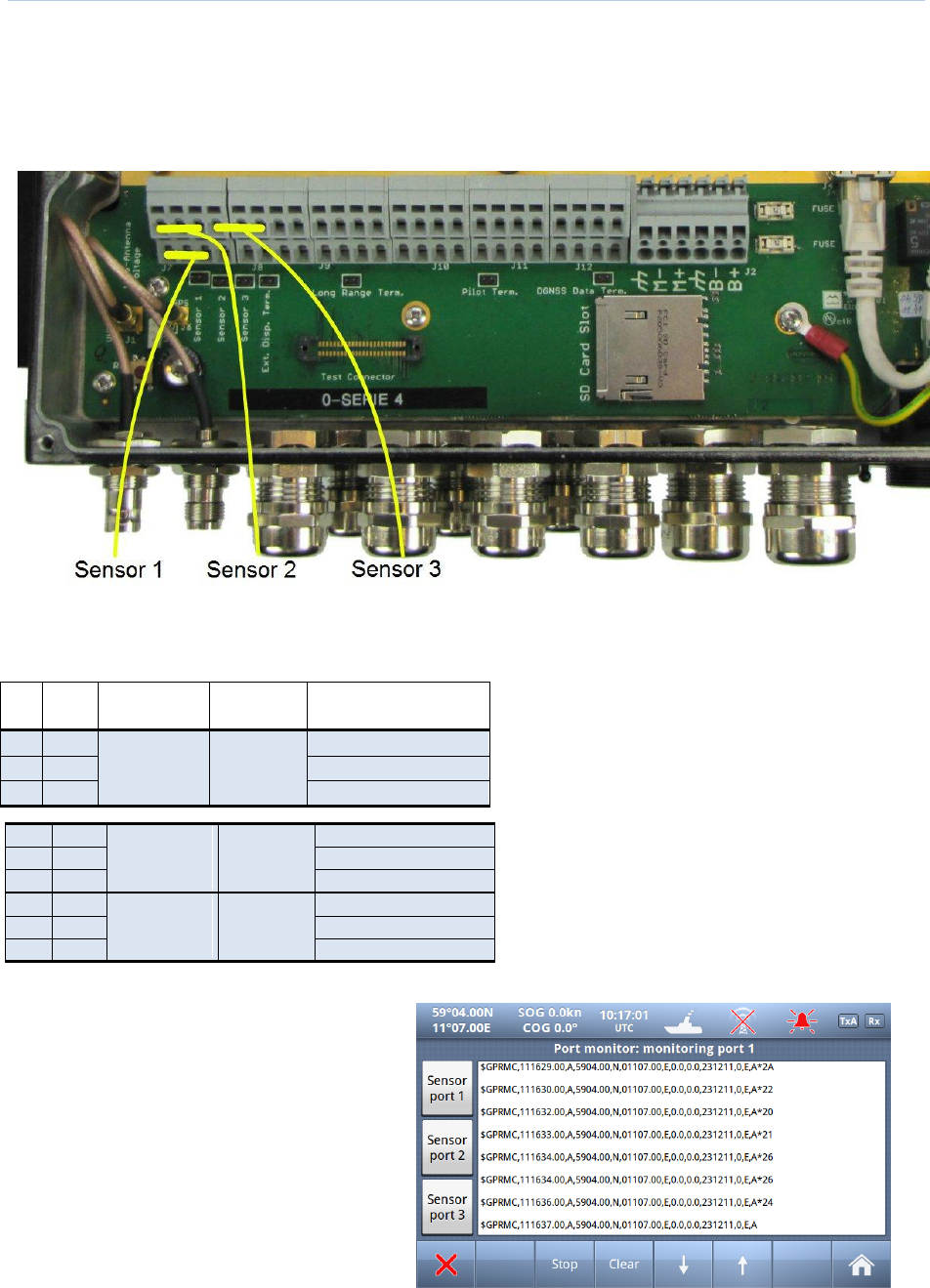
TR-8000 Operator and Installation Manual 54
8.3.1.4 Sensor connections
Sensors like GPS, Gyro, Speed log etc may be connected to the 3 different sensor inputs in the
TR-8000 Transponder unit.
Recommended cable diameter: 0.25 - 2.5mm2
The TR-8000 also offers a unique
feature of troubleshooting sensor problems
as it has a built in “Port monitor” which will
display all raw sensor data in the Display
Unit.
How to use this monitor, is described in
chapter 10.2.1.6
#
In/
Out
Type
Usage
Name
1
In
IEC61162-1
(RS422)
Sensor 1
RD1-B(+)
2
RD1 -GND (Iso Gnd)
3
In
RD1-A(-)
25
In
IEC61162-1
(RS422)
Sensor 2
RD6-B(+)
26
RD6-GND (Iso Gnd)
27
In
RD6-A(-)
28
In
IEC61162-1
(RS422)
Sensor 3
RD7-B(+)
29
RD7-GND (Iso Gnd)
30
In
RD7-A(-)
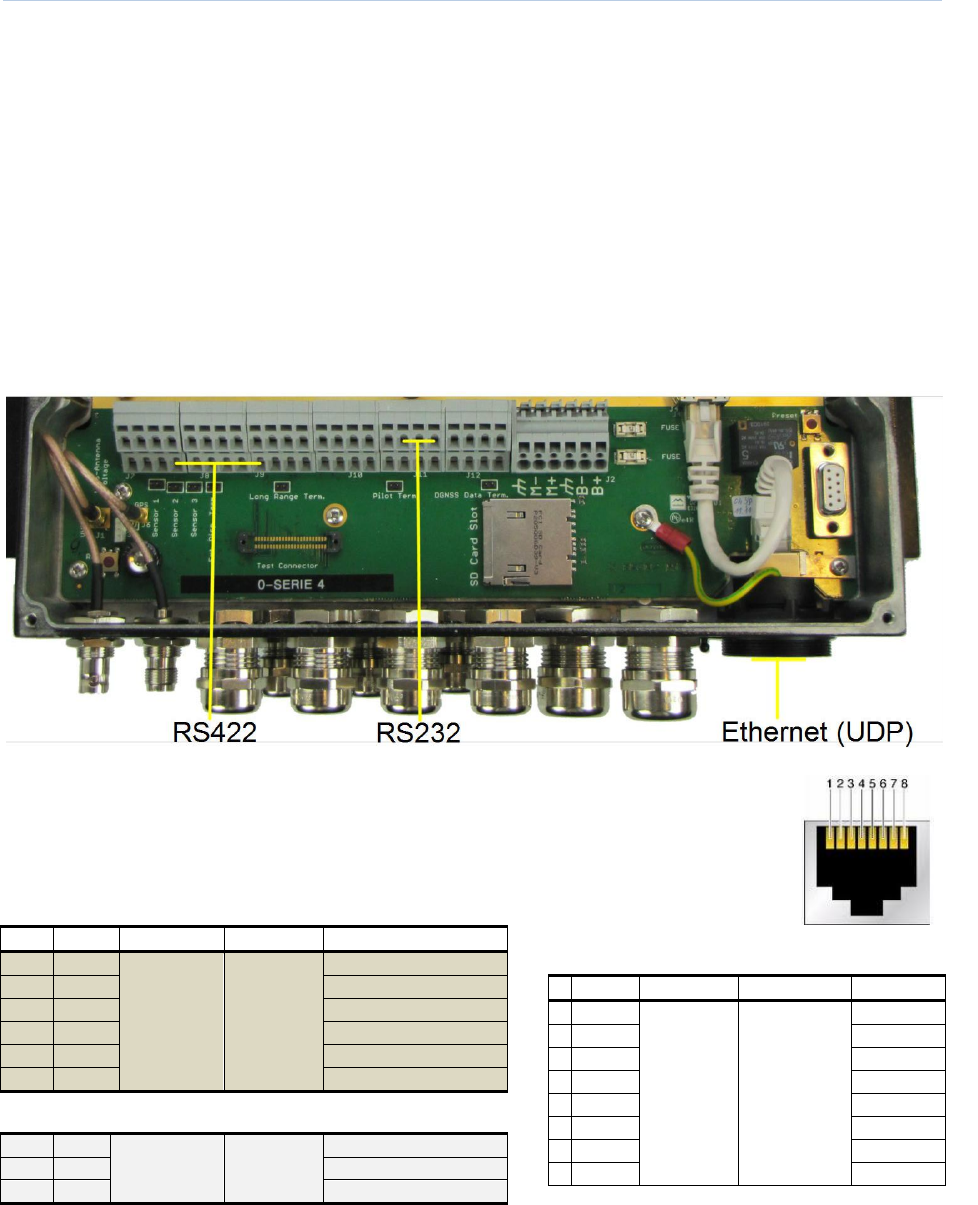
TR-8000 Operator and Installation Manual 55
8.3.1.5 External display – ECDIS/Radar connections
The TR-8000 have a very flexible solution when it comes to connecting ECS/ECDIS, Modern Radar or
Chart plotter for displaying AIS data on a more advanced display than the TR-8000 Display unit, which
only gives you basic text/graphic information.
On modern ECS, Radars, Chart plotters etc. the vessels received by the TR-8000 will be shown as a
separate “Layer” or “Overlay” with configurable alarms on collision probability (CPA/TCPA) together
with high resolution accurate charts.
The TR-8000 Transponder unit can be connected in three different ways:
1. RS422 (Default) , connections 4-9
2. RS232 , connections 42-44
3. Ethernet (UDP), connected either instead of the TR-8000 display unit, or together with a
network Switch in parallel with the Display Unit
See also chapter 10.2.1.2 which describes how to configure “External Display” options
and table in chapter 8.3.1.2 for details of pinouts
Default speed on this port is 38400 baud.
Please note! The “Ethernet” interface is auto detecting RX and TX similar as a network switch. You don’t
need to think about crossed cable or not !
#
In/Out
Type
Usage
Name
4
In
IEC61162-2
RS422
External
Display
RD2-B(+)
5
RD2-GND (Iso Gnd)
6
In
RD2-A(-)
7
Out
TD2-A(-)
8
TD2-GND (Iso Gnd)
9
Out
TD2-B(+)
#
In/Out
Type
Usage
Name
1
Out/In
Ethernet
(UDP)
100Base-T
TR-8000
Display Unit
Or
External
Display
TX+ / RX+
2
Out /In
TX- / RX-
3
In/Out
RX+ / TX+
4
-
-
5
-
-
6
In/Out
RX- / TX-
7
-
-
8
-
-
42
Out
RS232
External
Display
TX ( Transmit)
43
In
RX ( Receive)
44
232-GND( Ground )
Figure 8-12 External display connections
Figure 8-13 Ethernet RJ45 connector
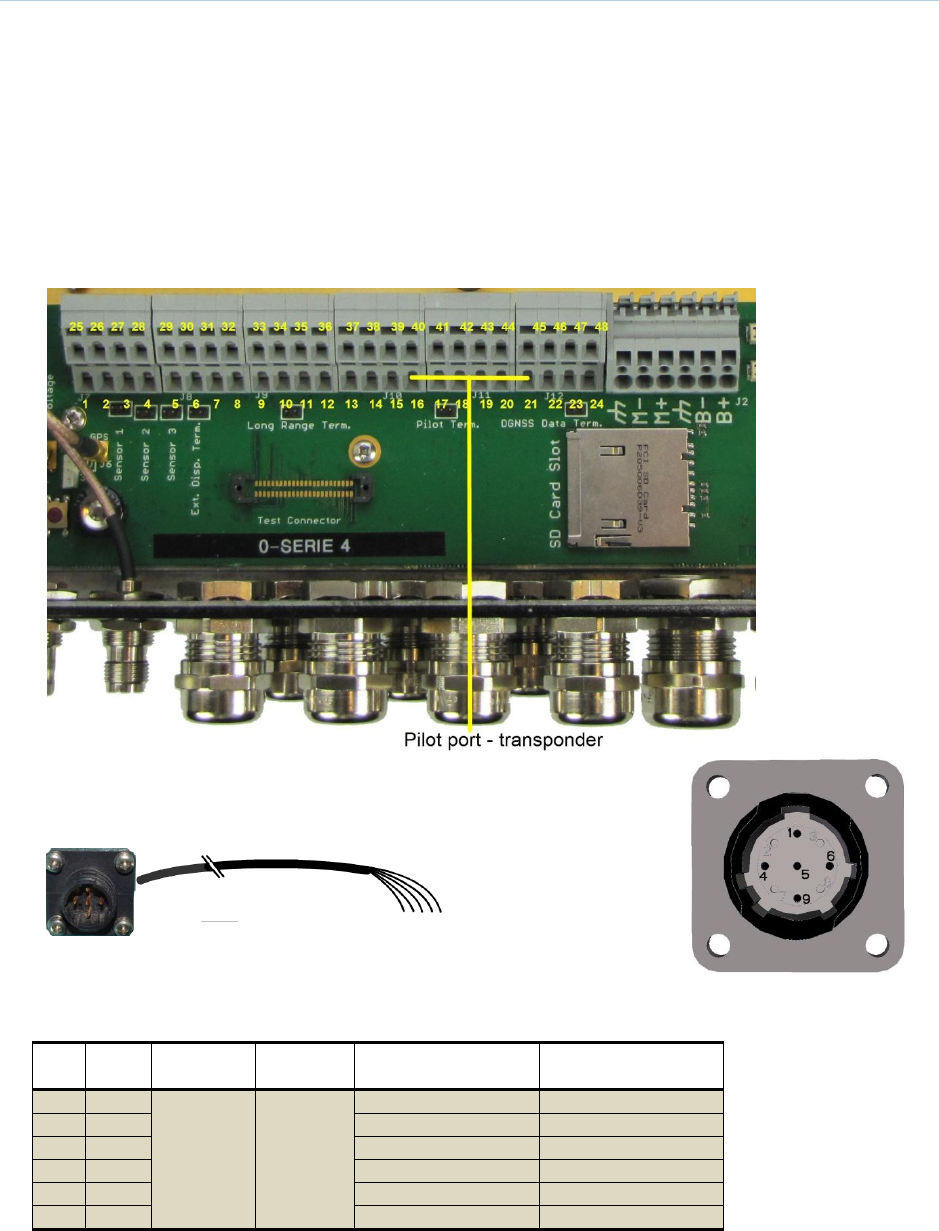
TR-8000 Operator and Installation Manual 56
8.3.1.6 Pilot / Aux. Display connection
This Port may be mandatory to be used with Pilot port connector (See picture below) on some kind
of vessels. Otherwise, this port may be used to connect a secondary display (Maybe ARPA radar, if
“External display” is connected to ECS/ECDIS)
This port is one of two options to connect a Pilot connector, as it is also possible to connect Pilot
port cable to the TR-8000 Display Unit, see chapters 8.3.2 and 10.2.1.3
Default speed on this port is 38400 baud.
#
In/Out
Type
Usage
Name
Connects to AMP
206486-1 Pin no:
16
In
IEC61162-2
(RS422)
Pilot / Aux
Display
RD4-B(+)
6
17
RD4-GND (Iso Gnd)
9
18
In
RD4-A(-)
5
19
Out
TD4-A(-)
1
20
TD4-GND (Iso Gnd)
21
Out
TD4-B(+)
4
Figure 8-15 AMP 206486-1 (Pilot
Plug) pinout
Figure 8-14 Pilot plug with cable
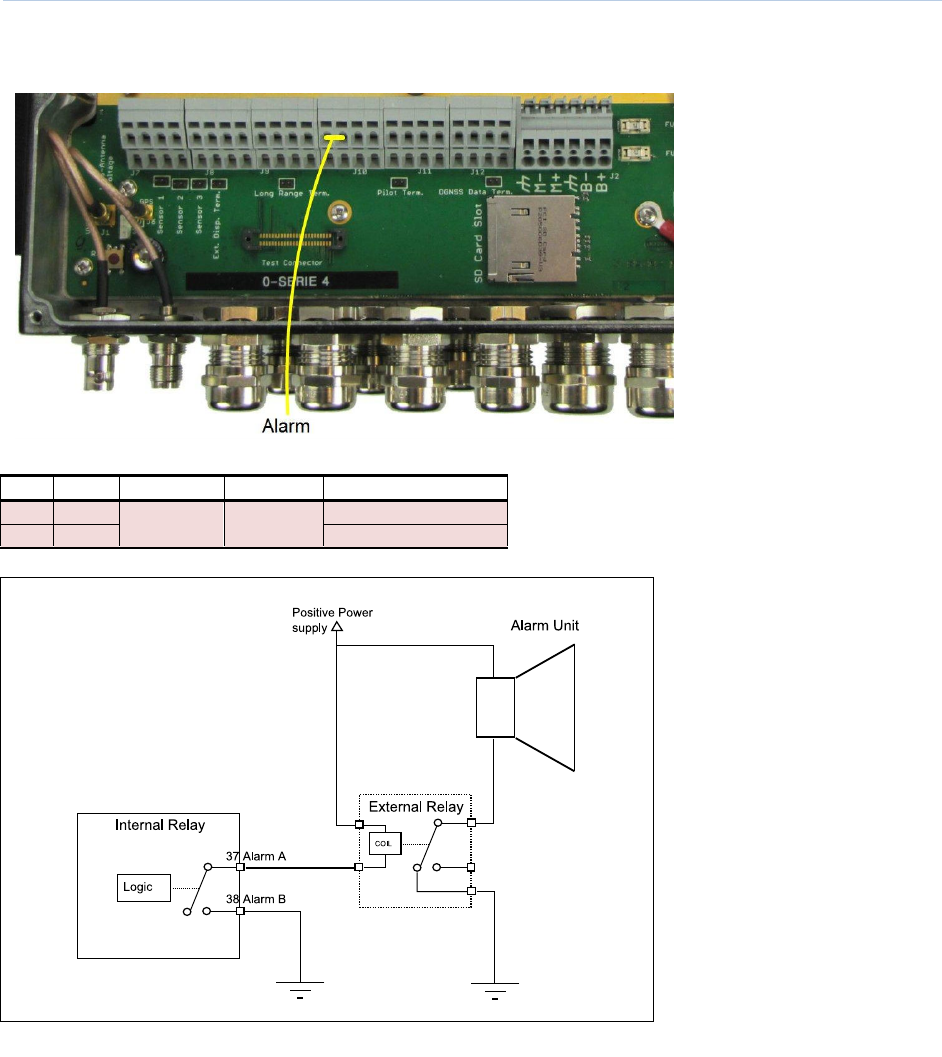
TR-8000 Operator and Installation Manual 57
8.3.1.7 Alarm Connection
Below picture shows where to connect external alarm to TR-8000
In this configuration,
both the external relay and
the alarm unit are powered
from external power source,
and the alarm unit is
grounded through the
external relay if an alarm
occurs or the main power to
the AIS is removed or
defective.
Other configurations
may be used, but remember
that the Alarm must function
both on AIS Alarm
conditions, and power failure
to the AIS.
The Alarm relay is a normally open earth free relay contact, provided as an independent and simple
method for triggering an external alarm. The alarm relay is active in case of power off and is capable of
driving a 2A current. The maximum voltage over the alarm relay must not exceed 48V. The alarm relay is
deactivated upon acknowledgment of an alarm, either internally on the display unit, or by an externally
provided ACK sentence. If the Transponder power is lost, and the Alarm relay has power, the alarm will
be triggered. In this case, the only way to deactivate the Alarm is to power the Transponder unit or
disconnect the power source of the Alarm relay.
#
In/Out
Type
Usage
Name
37
Out
Relay (NO)
Alarm
ALARM_A
38
Out
ALARM_B
Figure 8-16 Typical Alarm connection
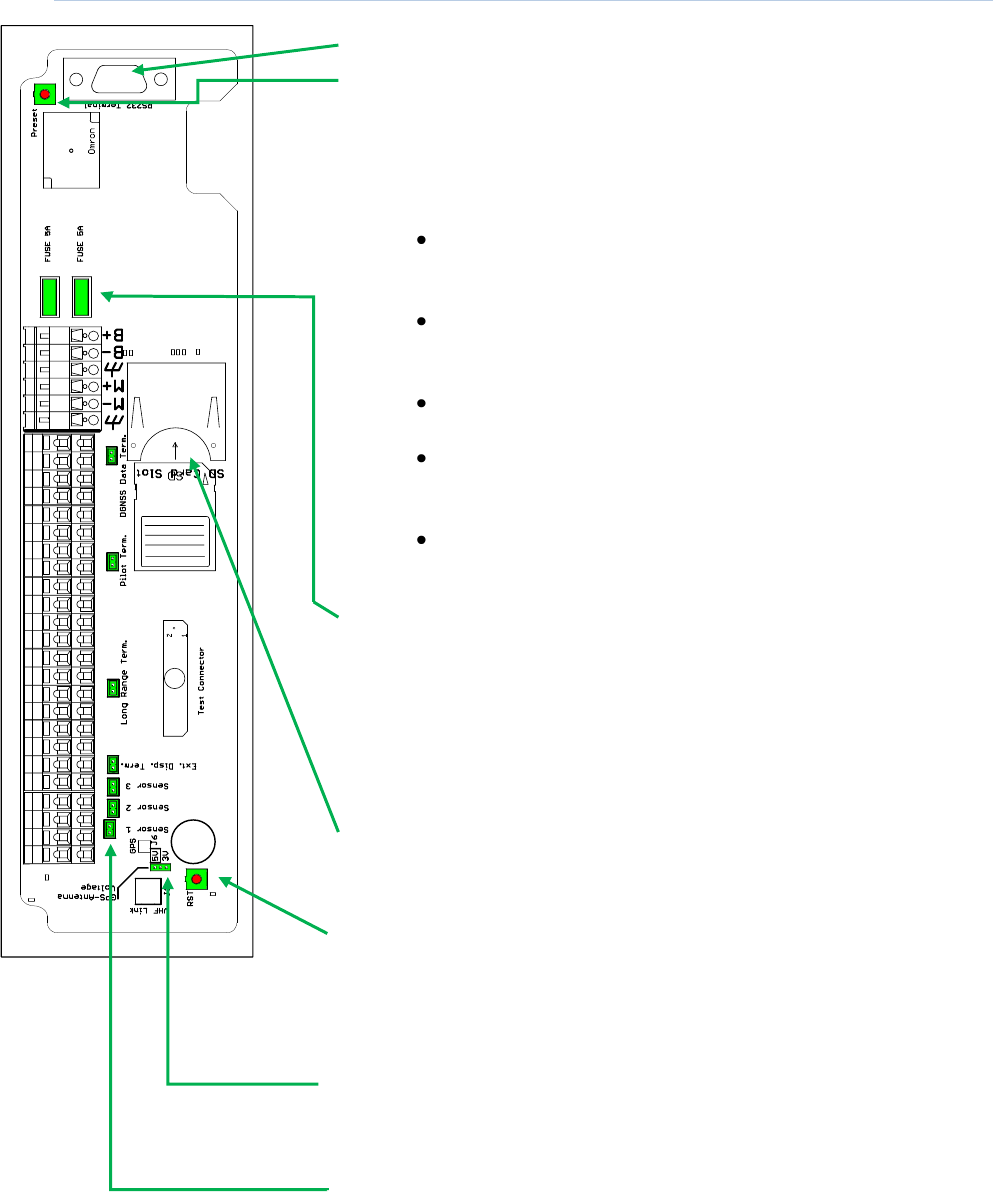
TR-8000 Operator and Installation Manual 58
8.3.1.8 Detailed description of connections, fuses, factory reset etc.
1 The RS-232 terminal is only for factory use
2 The upper right preset button can be used to restore factory
settings at two levels. It is assumed that no SD card is present in the
transponder SD card reader.
a. To reset the IP settings for the transponder and the connection
to the display to default values if these setting have been
reconfigured and are unknown:
Press the upper right preset button and apply power. Keep
the button pressed until the alarm LED starts flashing after
approx. 10 seconds. Then release the button immediately .
The IP settings are now reset to factory default
b. To restore the complete factory setting, all programmed
parameters are lost:
Press the upper right preset button and apply power.
Keep the button pressed.
Watch the alarm LED carefully, after approx. 10 sec it should
start flashing for 5 seconds and then stop. After some
seconds it will flash a sequence rapidly.
The preset button should now be released, and the factory
settings are now restored.
3 There are two fuses connected in series with the Main and Backup
power. There is no visual indication on fuse failure, but a quick
voltage measurement on each side of the fuse should give an
indication. If a fuse is blown, consider possible reasons for fuse
failure and replace the fuse if the reason for failure is repaired.
Spare fuses are provided. If all spares are used, contact distributor.
Replace fuses with identical fuses only. Use of other fuses or such
will make all warranty void.
4 The SD card reader is used for Software upgrades provided by
Jotron only. This must be performed by Jotron trained
Dealers/Distributors/Service Agents
5 The RST button is used to reset the almanac data of the internal
GPS in case of error. In order to reset the almanac, power off the
unit and then press the RST button for approximately 2s. When you
power up the unit again, the internal GPS will use some time to
obtain a fix. Approximately up to 15 minutes.
6 The GPS-Antenna Voltage jumper is used to select phantom feed
for an active antenna either 5 or 3.3V. The maximum
recommended current drawn from these ports is 50 mA.
7 The termination jumpers for the sensors, external display, pilot
terminal and DGNSS beacon are made available in order to lower
the differential input resistance of the port in order to enable for
longer cables. The differential input resistance is approximately
7700 Ohm without jumper and 240 Ohm with the jumper
connected.
TR-8000 Operator and Installation Manual 59
8 Default Transponder IP address: 10.0.0.10
9 Default Display IP address:10.0.0.11
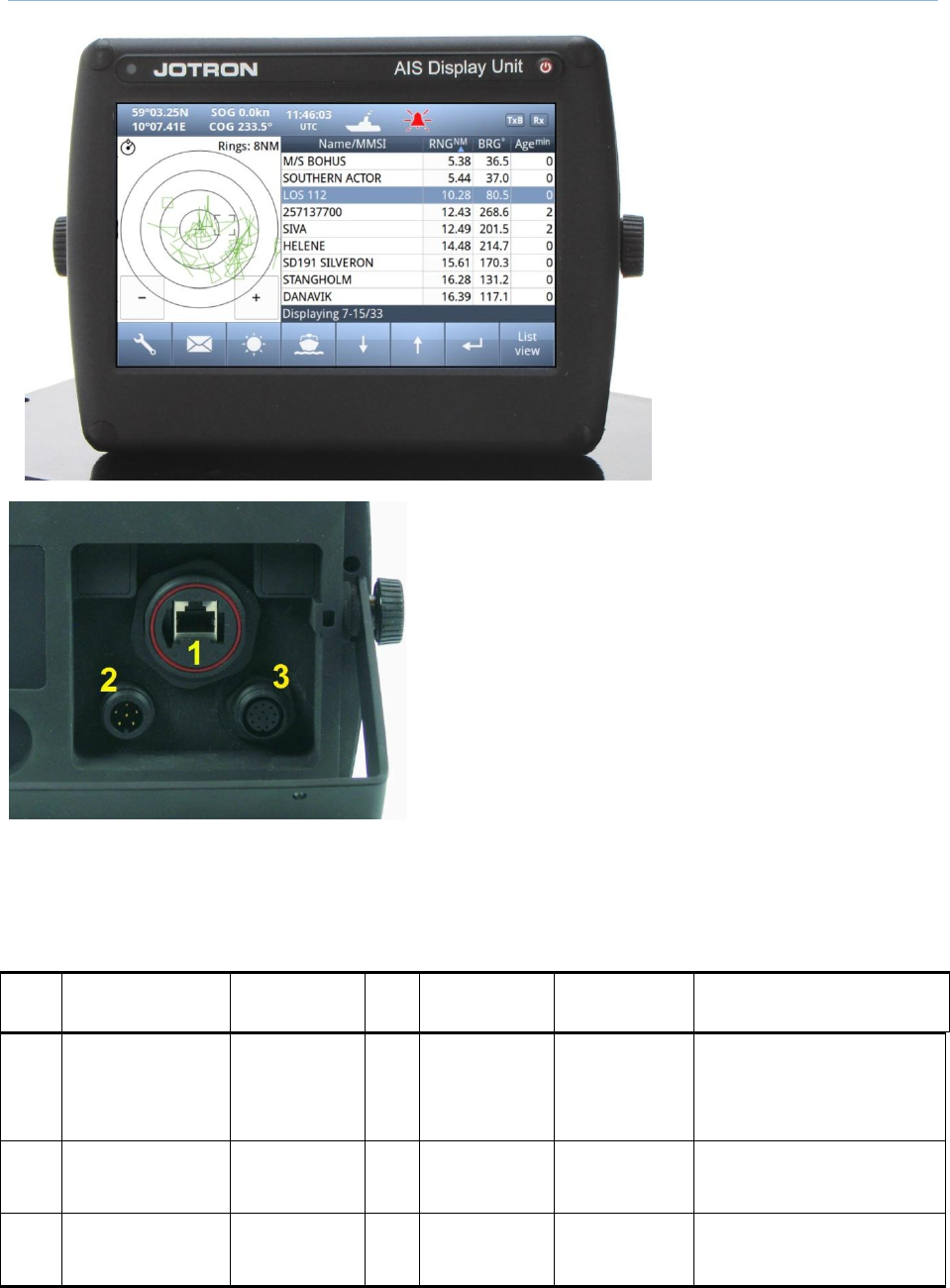
TR-8000 Operator and Installation Manual 60
8.3.2 Display Unit:
The TR-8000 Display Unit has three different
connectors on the rear
#
Description
Type
Pins
Mating
Plug/Socket
Manufacturer
Other
1
Transponder
Ethernet
Buccaneer/
Jotron
8
Jotron
Partno:
86145
Bulgin
Std delivery: 5m cable
with Ethernet Buccaneer
in each ends.
See 8.2.3
2
Power
Buccaneer
6
PX0410/06/S
Bulgin
Jotron made cable,
Partno: 86581
3
Pilot
Buccaneer
12
PX0410/12/P
Bulgin
Jotron made cable,
Partno: 86870
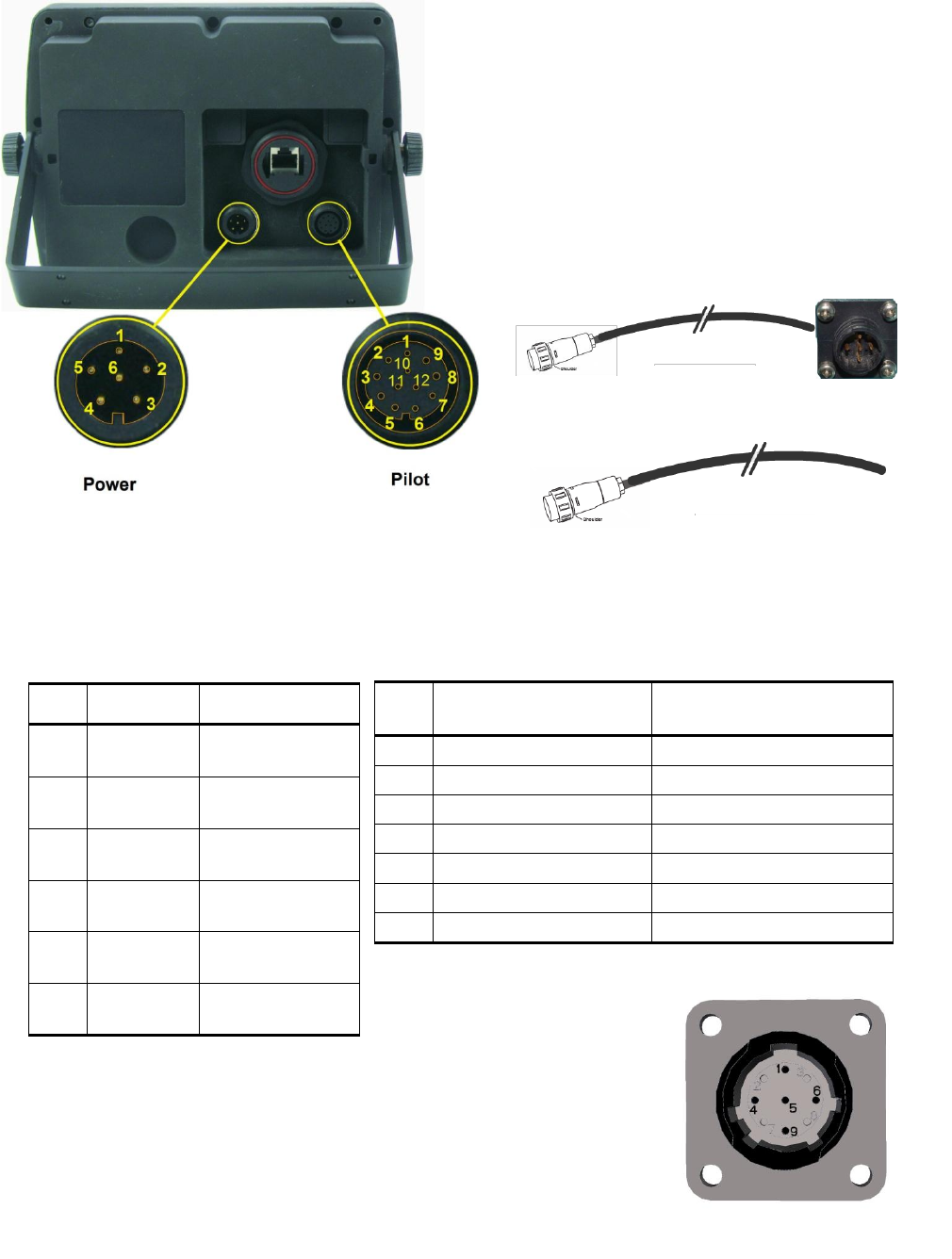
TR-8000 Operator and Installation Manual 61
The cable between transponder and
display is described in chapter 8.2.3 and
below is the “Power” and “Pilot” connectors
described.
The type of mating connectors are
described in the table on previous page, and
for both these connections, a prefabricated
cable is a part of standard delivery of a
Jotron TR-8000 AIS.
Below is a table showing pinouts for the two connectors:
Power (86851): Pilot (86870):
The Pilot connector may
either be connected to the
Display Unit as described
here, or to the transponder
unit as described in chapter
8.3.1.6
#
Name
Colour
1
MAIN
12 - 24 VDC
Green
2
GND
(Chassis)
Shield
3
BACKUP
12 - 24 VDC
Yellow
4
BACKUP
0 VDC
Brown
(common with 5)
5
MAIN
0 VDC
Brown
(common with 4)
6
Do Not
connect
#
Name
Connects to AMP
206486-1 Pin no:
1
Floating Ground
2
TDA Out
1
3
TDB Out
4
4
Floating Ground
9
5
RDA In
5
6
RDB in
6
7-12
Do Not Connect
Figure 8-17 Partno.: 86870, Pilot plug cable, Display Unit
Figure 8-18 Partno.: 86581, Power cable, Display Unit
Figure 8-19 AMP 206486-1
Pinout

TR-8000 Operator and Installation Manual 62
Transponder (RJ45):
Please note! The Transponder “Ethernet” interface is auto detecting RX and TX similar as a network
switch. You don’t need to think about crossed cable or not !
#
In/Out
Type
Usage
Name
1
Out/In
Ethernet
(UDP)
100Base-T
TR-8000
Display Unit
Or
External
Display
TX+ / RX+
2
Out /In
TX- / RX-
3
In/Out
RX+ / TX+
4
-
-
5
-
-
6
In/Out
RX- / TX-
7
-
-
8
-
-
Figure 8-20 Ethernet RJ45 connector
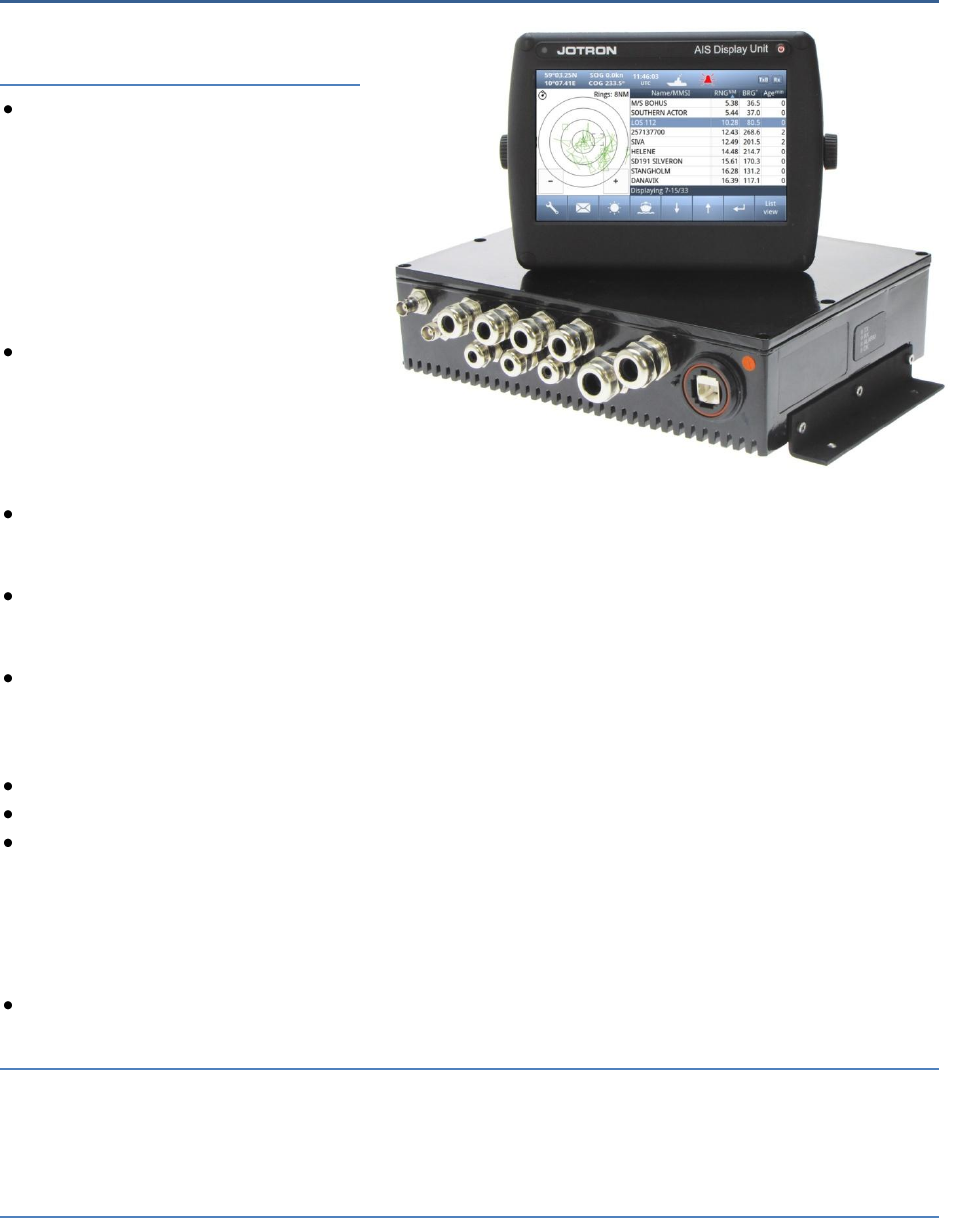
TR-8000 Operator and Installation Manual 63
9 Initial configuration
9.1 Short reference for initial
configuration
Fill in Own Ship (Ch. 10.1.1)
o Ship Name
o IMO number
o MMSI –“-
o Call Sign
o GPS antenna positions
(Internal & external)
o Type of Vessel
Check GPS and position:
o internal GPS signal
strength (ref ch. 10.2.4)
o Current position: ( Ref
ch.10.2.8)
Configure External Display Interface( ch. 10.2.1.2 )
o RS422, RS232 or Ethernet
Configure Pilot port interface( ch. 10.2.1.3 )
o Display or Transponder
Check External Sensor communication
o Indicators (ch. 10.1.4 ) - shows Sensors detected
o Port Monitor (ch. 10.2.1.6 ) – shows RAW data from Sensor 1 to Sensor 3
Check External Display communication ( ch.8.3.1.5 )
Check Communication test (ch. 10.2.2.5)
Fill in Voyage Settings (Ch. 7.3)
o Navigational status
o Destination
o ETA
o Draught
o Cargo Category
Check reception of ship in ship list – normal operation (ch. 7.2.6)
9.2 Not all ships carry AIS
It is important to remember that not all ships carry AIS, in particular leisure crafts, fishing
boats, warships and some coastal shore stations including Vessel Traffic Service Centers.
9.3 Use of AIS in collision avoidance
As an anti-collision aid the AIS has some advantages over radar:
- Capable of instant presentation of target course alternations.
- Not subject to target swap.
- Not subject to target loss in clutter.

TR-8000 Operator and Installation Manual 64
- Not subject to target loss due to fast manoeuvres.
- Able to detect ships within VHF/FM coverage.
IMPORTANT
When using the AIS for anti-collision purposes it is important to remember that the AIS is an
additional source of navigation information. It does not replace other navigational systems. The
AIS may not always give the right picture of the traffic in your area separately.
9.4 Erroneous information
Erroneous information implies a risk to other ships as well as your own. Incorrectly configured
or calibrated sensors might lead to transmission of incorrect information. It is the user’s
responsibility to ensure that all information entered into the system is correct and up to date.
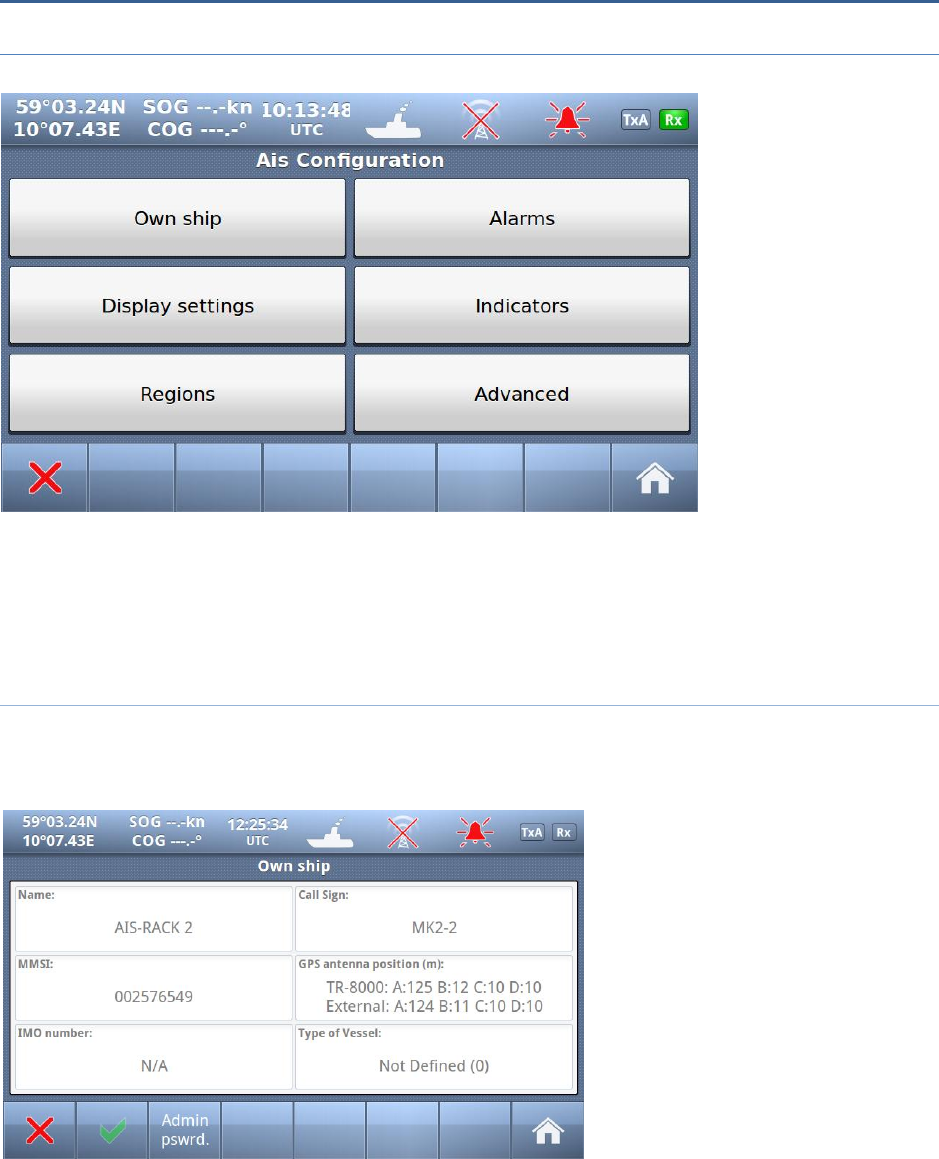
TR-8000 Operator and Installation Manual 65
10 Operation Instructions
10.1 Configuration Menu
The AIS configuration menu consists of six menus, containing the settings and configurations most
applicable to the user. Some settings are write-protected by administrator password, but the user is
always allowed to view the current settings.
10.1.1 Own Ship
The own ship configuration is for setting the static data of the ship and is primarily only used during
setup/installation but should also be checked regularly (at least once a month).
See available settings on the display
shown here
To be able to change values, the
Admin pswrd button must be
pressed and the password must be
entered (Default: SE)
Vessel name, Call sign, MMSI and
IMO are all text or numbers and may
entered easily
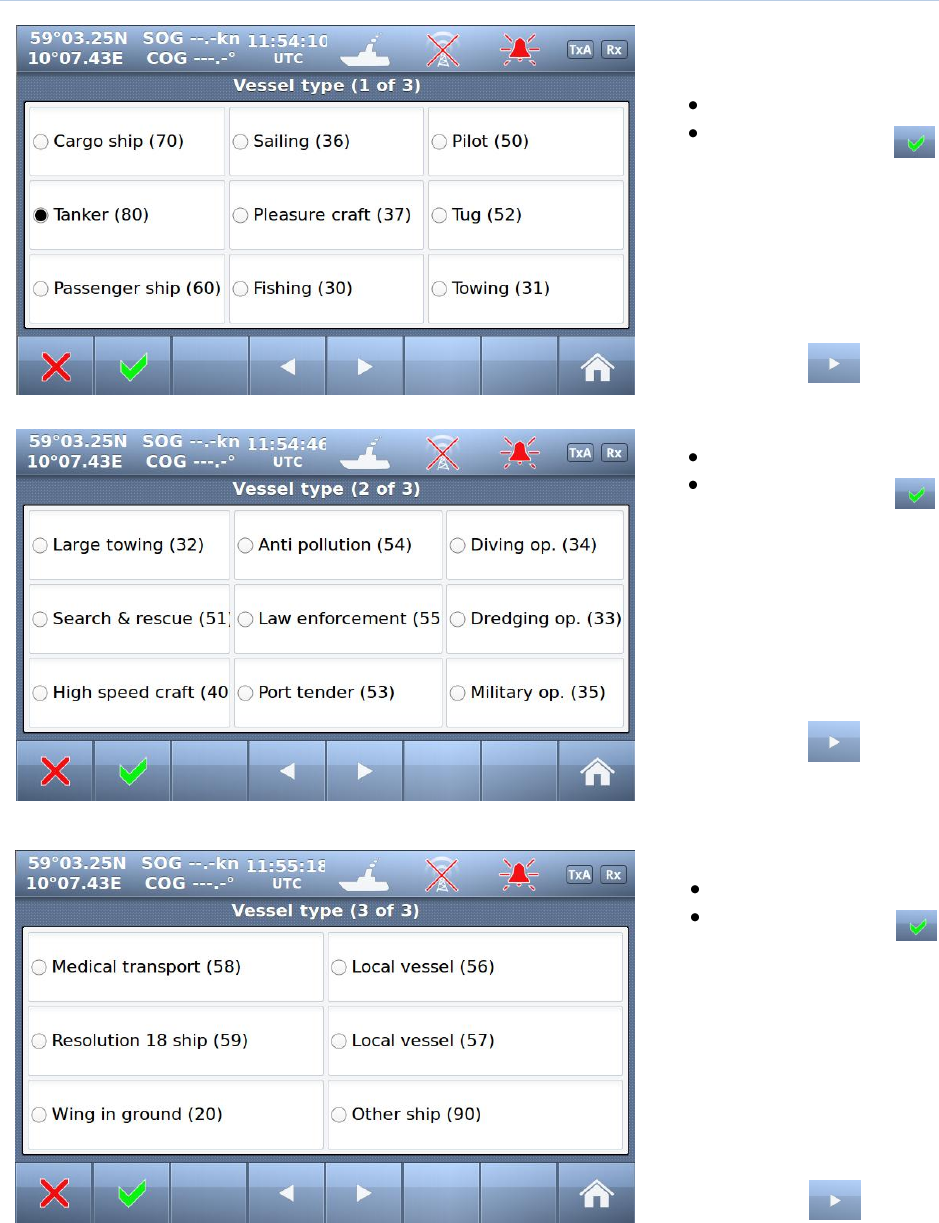
TR-8000 Operator and Installation Manual 66
10.1.1.1 Type of Vessel
Select Type of Vessel
Confirm with
Or if not in the list, continue to
next page with
Select Type of Vessel
Confirm with
Or if not in the list, continue to
next page with
Select Type of Vessel
Confirm with
Or if not in the list, continue to
next page with
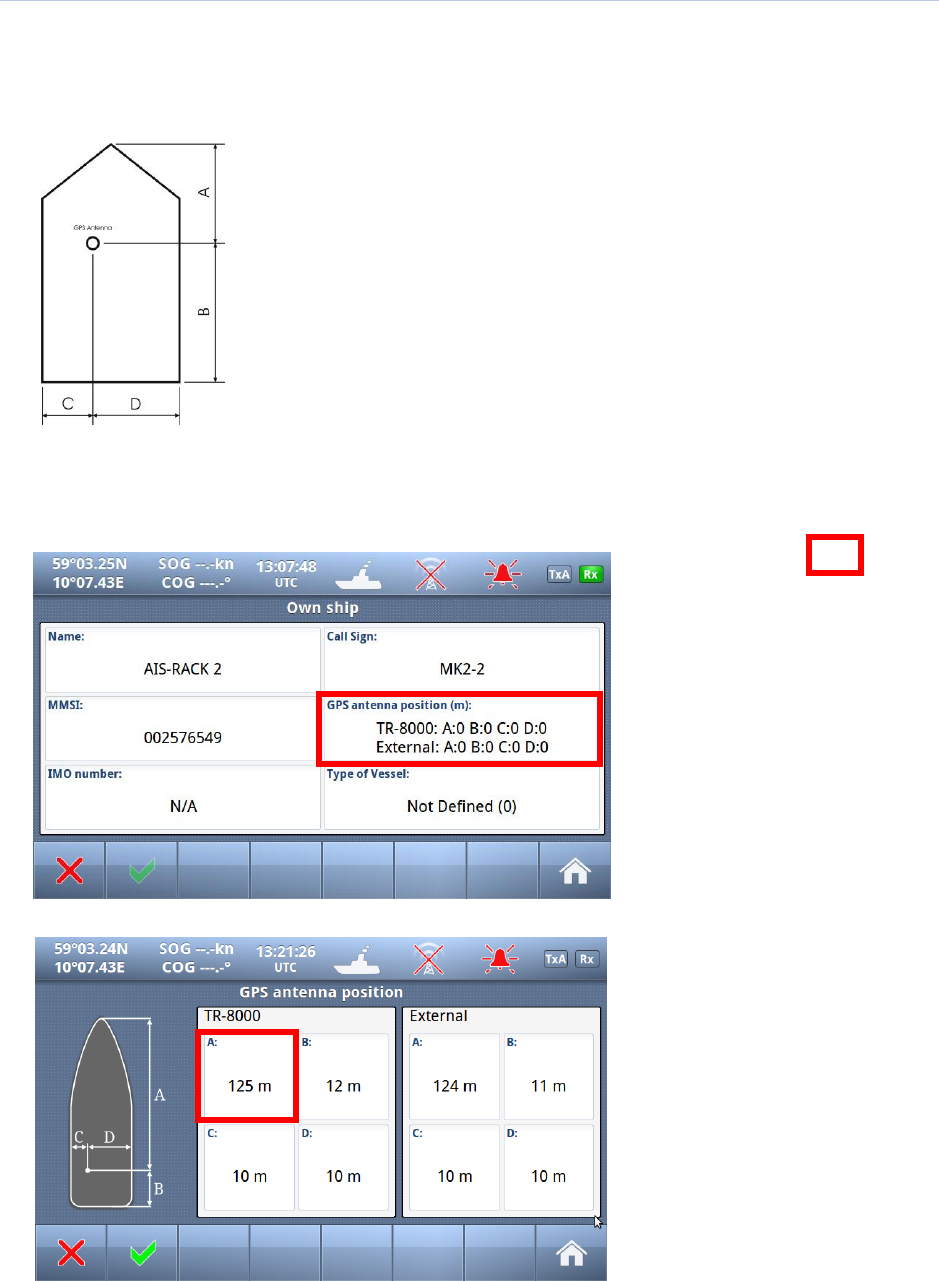
TR-8000 Operator and Installation Manual 67
10.1.1.2 Ship Dimension and Antenna Position
In order to calculate the correct location of own ship relative to other ships, the exact position of the
GNSS antennas and the dimension of the ship need to be specified.
The setting of the Ship Dimensions and the Antenna positions are combined as follows:
Figure 1: Ship Dimension and GPS antenna position.
Both the position of the internal and the external GPS antenna need to be set
To configure “GPS Antenna position”, select directly on the Touch screen:
Red square shows
button selected to get to next
menu
TR-8000 -> means position of the
antenna connected directly or via
a signal splitter to the
transponder.
External -> means the position of
the GPS antenna which is
connected to an external GPS
which feeds IEC 61162-1
messages to the transponder.
Click on “A”-“D” for “TR-8000”
and “External” and input correct
values. Then the length and width
of the ship will also be defined
A: Distance from bow to GPS antenna position in meters.
B: Distance from stern to GPS antenna position in meters.
C: Distance from port to GPS antenna position in meters.
D: Distance from starboard to GPS antenna position in meters.
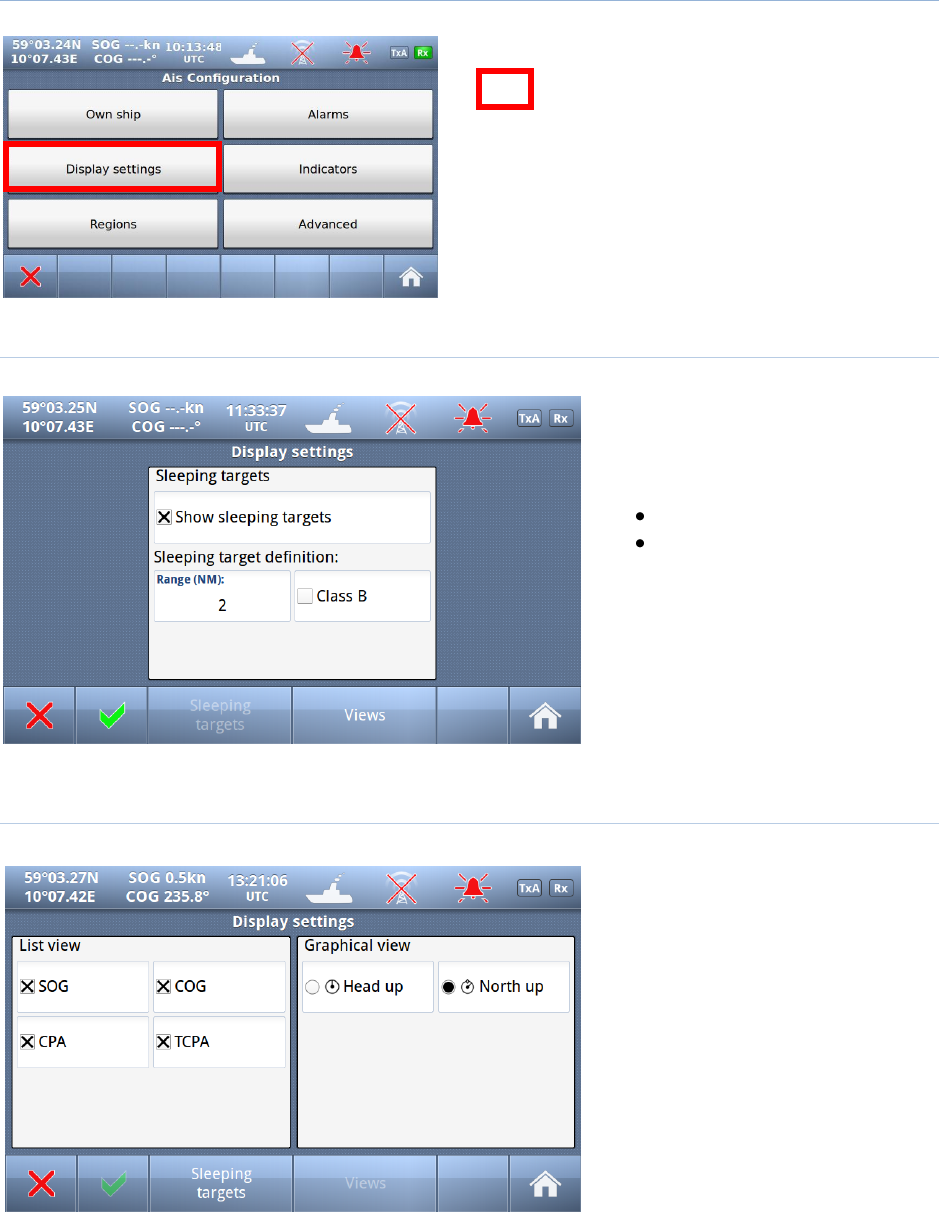
TR-8000 Operator and Installation Manual 68
10.1.2 Display Settings
Red square shows
button selected to get to next menu
10.1.2.1 Sleeping Targets
The first “Display settings” menu
configures “Sleeping targets” based
on:
Range
Class B
The “sleeping targets” may not be
shown
“Views” may be configured by
pressing this button on the “Button
Bar”
10.1.2.2 Views
Here we can configure which
columns shall be shown in “Ships
List” (chapter 7.2.6) and if we want
“Head up” or “North up” in
“Graphical view”(chapter 7.2.7).
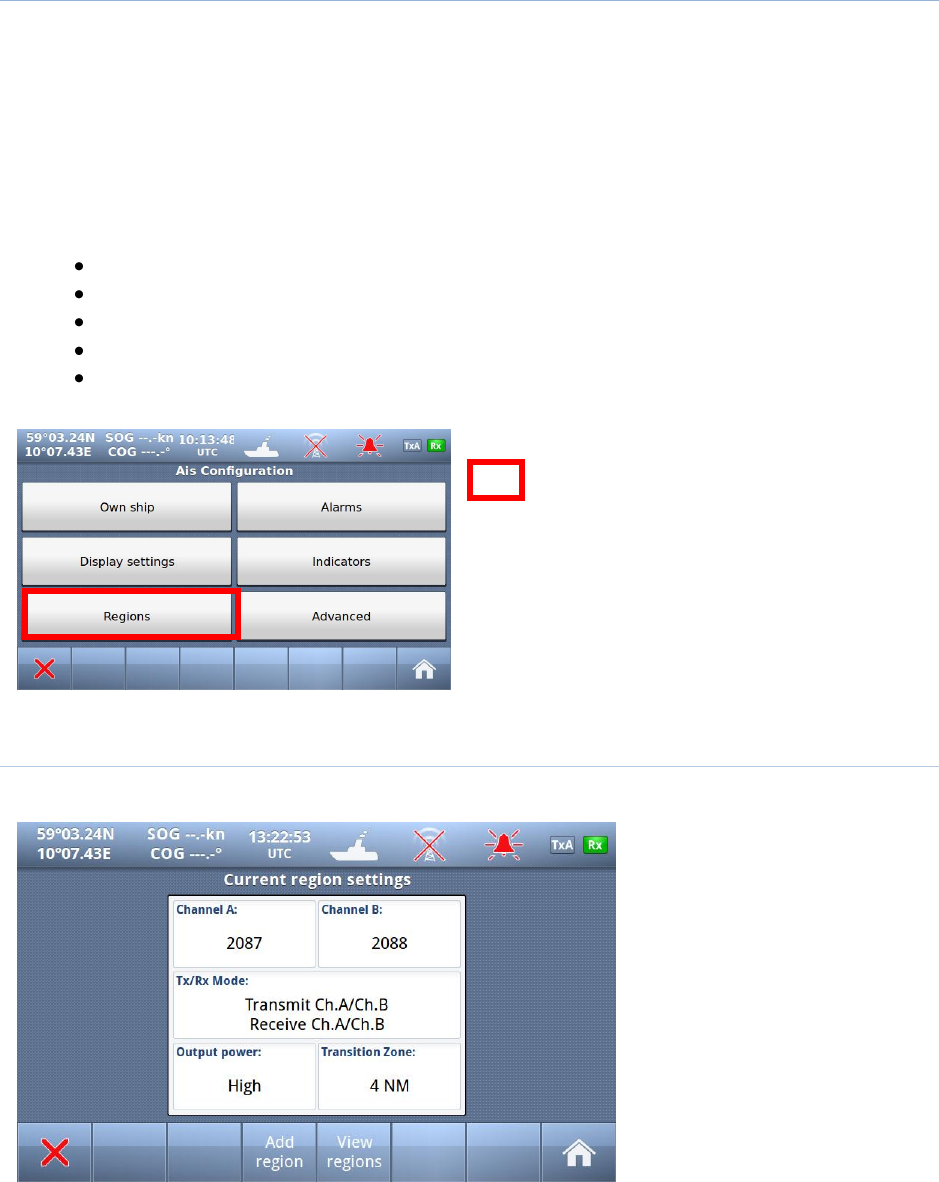
TR-8000 Operator and Installation Manual 69
10.1.3 Regional Settings
The Regional Settings are primarily used by local base stations to assign special frequencies or
transmitter configurations for certain areas. It is also allowable to add or edit the regions, but this
should be done with caution, as incorrect frequency settings for an area will disable the functionality
of the AIS system. Altering the regional settings is protected by a user password. The Area named HIGH
SEA, is the default area and contains the whole world, except from the other regions, if defined.
Each Region is defined by the following parameters:
Area, defined as North East corner and South West corner
Two channels used for VHF communications
Rx/Tx mode is used to restrict the transmission to one of the two channels.
Output Power is chosen between High or Low setting (1W or 12.5W)
Transitional zone defines the area surrounding an area in order to switch the frequencies in
a step by step order. The transitional zone defined between 1 and 8 NM
Red square shows
button selected to get to next menu
10.1.3.1 Current Region settings
This is “Current Region settings”
the TR-8000 is using now
From here, we can either “View”
or “Add region”
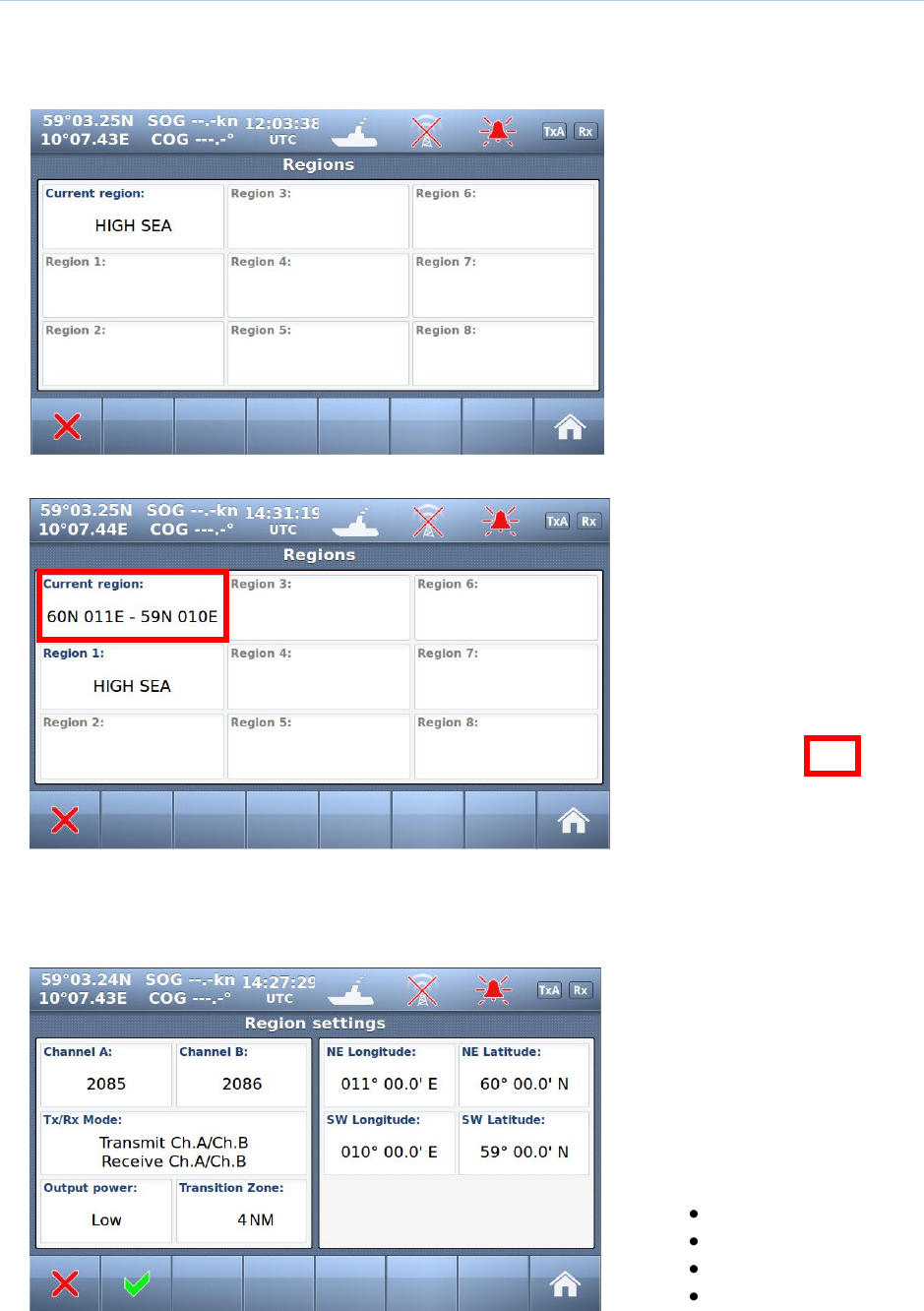
TR-8000 Operator and Installation Manual 70
10.1.3.2 View Regions
It is possible to view the settings of a given region by selecting a region in the regions list and pushing
the View Region button.
Example of standard TR-8000
without any extra Regions
defined
Example configuration with one
extra Region defined
Red square shows
button selected to get to next
menu
10.1.3.2.1 View Custom defined Regions
For Custom defined Regions
(Either configured by the user of
TR-8000 or configuration is
received from an AIS Base Station
in a special message) the Region
have in addition North East
position and a South West
position defining the area in
which the special settings of :
Channels
Tx/Rx mode
Power
Transition zone
